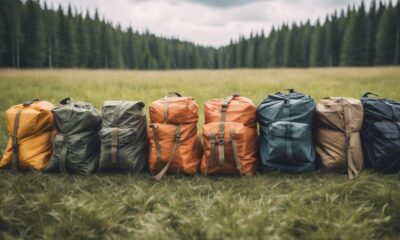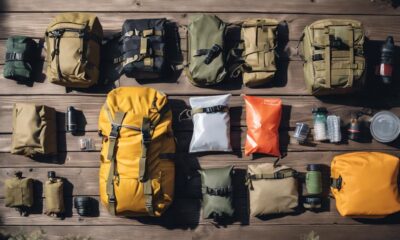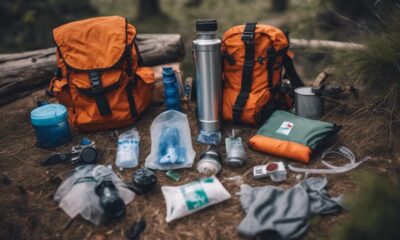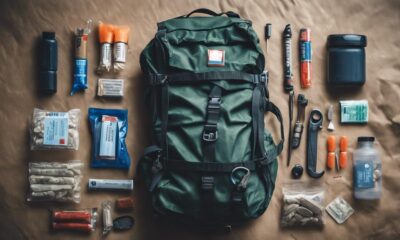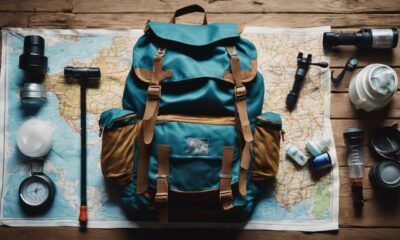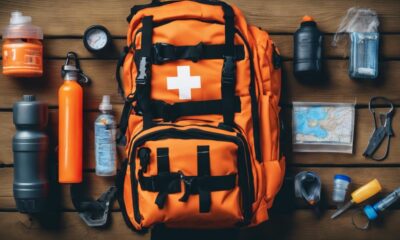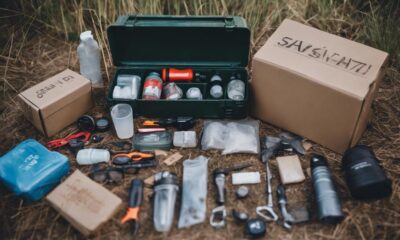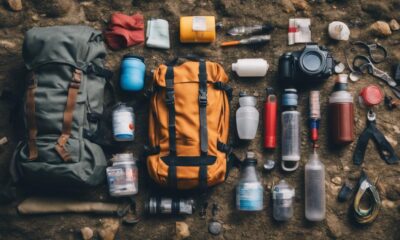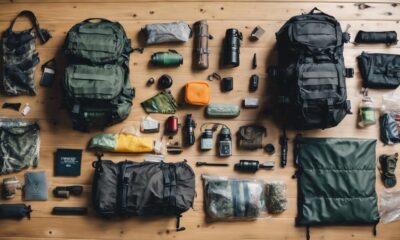Survivalism
Master the Art of Concealed Weapon Caching
Join us to uncover the secrets of concealed weapon caching and discover strategies that could change your approach to security forever.

To master concealed weapon caching, start by understanding local laws on weapon storage. Focus on both indoor and outdoor methods. Use hidden compartments or decoy items in your home, and consider burying weapons in waterproof containers outdoors. Always prioritize safety by limiting knowledge of your cache to trusted individuals and regularly checking your setups for integrity. Stay aware of your surroundings to gauge potential threats. Joining prepper communities can provide invaluable support and knowledge. By honing these skills, you'll enhance your readiness and security. There's much more to explore on this essential topic if you're enthusiastic to learn.
Key Takeaways
- Understand and comply with local laws regarding weapon storage and caching practices to avoid legal issues.
- Utilize purpose-built furniture and decoy items for effective indoor concealment while maintaining accessibility.
- Choose discreet, high-ground locations for outdoor caches, using waterproof containers to protect firearms from moisture.
- Regularly inspect cache locations and maintain firearms to ensure functionality and security.
Legal Considerations for Caching
When caching weapons, understanding the legal landscape is vital to avoid potential repercussions and guarantee responsible ownership. Research local laws regarding weapon storage and caching practices, as regulations can vary widely.
You're legally allowed to create multiple caches, provided you engage in no criminal activity. Always consider the ethical implications of hiding weapons, especially regarding access by children or inexperienced individuals.
Be aware of the liability that comes with cache misuse; knowing the potential legal consequences is indispensable. Transparency is key, so communicate your plans with trusted individuals to maintain accountability.
Indoor Caching Techniques
Indoor caching techniques prioritize stealth and accessibility, ensuring your firearms remain concealed yet readily available when needed.
To effectively hide your weapons indoors, consider these strategies:
- Purpose-built furniture: Use items like coffee tables or shelves with hidden compartments to keep firearms in plain sight.
- Gun magnets: Securely attach firearms in unexpected locations, like under a desk or behind a cabinet.
- Decoy items: Hollowed-out books can hide firearms and accessories, making them blend seamlessly with your decor.
- Temporary caches: Utilize clothing pockets for quick access; you never know when you'll need immediate protection.
Outdoor Caching Methods
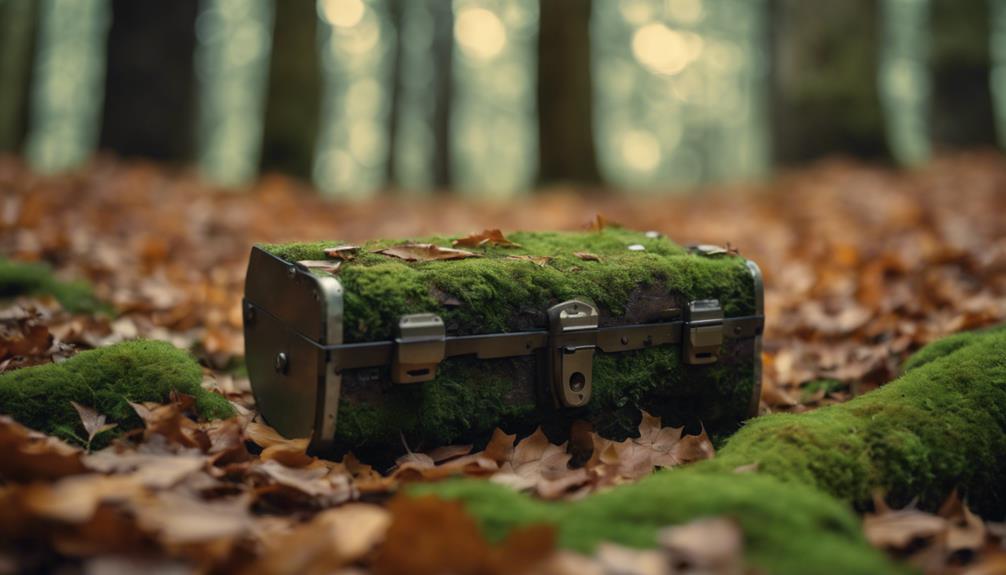
Burying weapons remains a popular and effective method for outdoor caching, offering both concealment and protection from the elements.
To guarantee moisture protection, use waterproof containers like PVC pipes or military ammo cans, and add silica gel packets inside.
Choose discreet, high-ground locations that avoid flooding risks, and don't bury on public or unauthorized private property.
Mark your cache locations discreetly for future retrieval, but keep this information secure.
When selecting weapons, consider affordable firearms to minimize loss risk. A reliable semi-automatic rifle, a shotgun, and a .22 LR rifle provide versatility for hunting and defense.
Safety Protocols for Caching
Establishing effective safety protocols is essential for guaranteeing the security and accessibility of your weapon caches. By implementing strong guidelines, you can minimize risks and enhance your peace of mind.
Here are four vital safety protocols to keep in mind:
- Evaluate Threat Levels: Always assess potential risks before choosing cache locations.
- Limit Access: Only share cache details with trusted individuals to maintain security.
- Regular Maintenance: Periodically inspect your caches to verify their integrity and functionality.
- Emergency Preparedness: Have a clear plan for quick access to your weapons when necessary.
Situational Awareness Enhancements
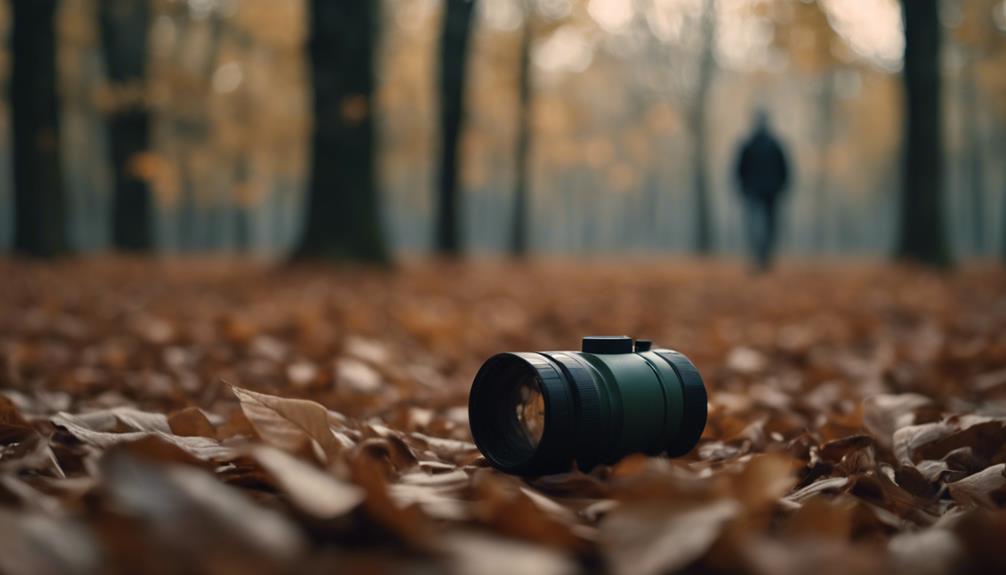
Enhancing your situational awareness is vital for effectively managing weapon caches and guaranteeing your safety in various environments.
Start by regularly evaluating potential threats around you. Be aware of your surroundings and identify any unusual behaviors or activities that could indicate danger.
Choose weapon types that suit specific situations and practice accessing them quickly.
When scouting locations for your caches, prioritize discreet and secure areas. Monitor these locations frequently to confirm they're still safe and undisturbed.
Adapt your strategies as circumstances change, and maintain secure storage with lockable containers.
Limit knowledge of cache locations to trusted individuals, and conduct regular inspections to keep everything in prime condition.
Community Resources and Support
Building a strong network within your community can greatly bolster your resources and support for weapon caching strategies. Engaging with others who share your interests can provide valuable insights and enhance your preparedness.
Here are some ways to connect and grow your support system:
- Join prepper networks: Share experiences and strategies to improve your techniques.
- Attend workshops: Gain hands-on skills from experts to refine your caching methods.
- Access educational materials: Learn the latest best practices and stay informed on survival tactics.
- Collaborate with experienced preppers: Tap into their knowledge to navigate challenges effectively.
Best Practices for Maintenance
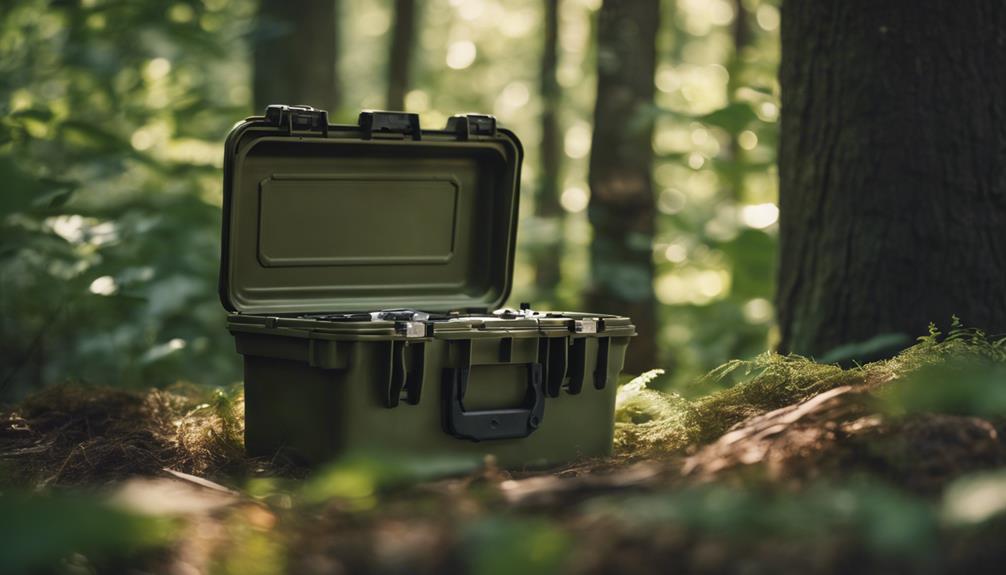
Regularly inspecting your weapon caches guarantees they remain secure and functional over time. Make it a priority to check both the condition of your weapons and the integrity of your storage methods. Use the following table to guide your maintenance routine:
| Maintenance Task | Frequency |
|---|---|
| Inspect cache location | Every 3 months |
| Clean firearms | After each use |
| Check seals and containers | Monthly |
| Update cache inventory | Every 6 months |
| Test retrieval process | Annually |
Frequently Asked Questions
How Do I Choose the Right Location for a Cache?
To choose the right location for a cache, assess potential risks, scout discreet areas, and avoid low-lying spots. Guarantee accessibility while prioritizing security, and remember to monitor surroundings regularly for any changes.
What Types of Firearms Are Best for Caching Purposes?
When choosing firearms for caching, think of them as your trusty companions. Opt for affordable, versatile options like a semi-automatic rifle, shotgun, or .22 LR. They'll serve you well in various scenarios and conditions. Additionally, consider the specific environment where the cache may be needed, especially if you’re prepping for city conditions. The best firearms for urban survival should offer reliability in close-quarter settings; compact options with manageable recoil and easy maneuverability are ideal. Make sure to store ample ammunition and maintenance supplies alongside them to ensure functionality when you need it most.
How Do I Ensure My Cache Remains Undetected?
To keep your cache undetected, choose discreet locations, use inconspicuous containers, and regularly check surroundings. Maintain access control by informing only trusted individuals and adapt your strategies based on potential risks or changes.
Can I Cache Ammunition Alongside My Weapons?
Yes, you can cache ammunition alongside your weapons, ensuring both are stored securely. Just remember to adhere to local laws, maintain proper storage conditions, and keep accessibility in mind for quick retrieval when needed.
What Should I Do if I Forget My Cache Location?
If you forget your cache location, retrace your steps mentally. Check notes or markers you might've left. Consider using landmarks or creating a map for future reference. Regularly revisit and refresh your memory on locations.
Conclusion
In mastering the art of concealed weapon caching, you're not just securing your firearms; you're building a fortress of preparedness around yourself and your loved ones.
By staying informed about legal considerations and honing your skills in both indoor and outdoor methods, you're weaving a safety net that protects you in uncertain times.
So, take these insights to heart, and remember: a well-prepared individual is like a lighthouse in a storm, guiding the way to safety.
Survivalism
Urban Prepping: Apartment-Friendly Storage Solutions
Get ready to discover innovative storage solutions that will maximize your apartment space and keep everything organized—there’s a world of creativity waiting for you!
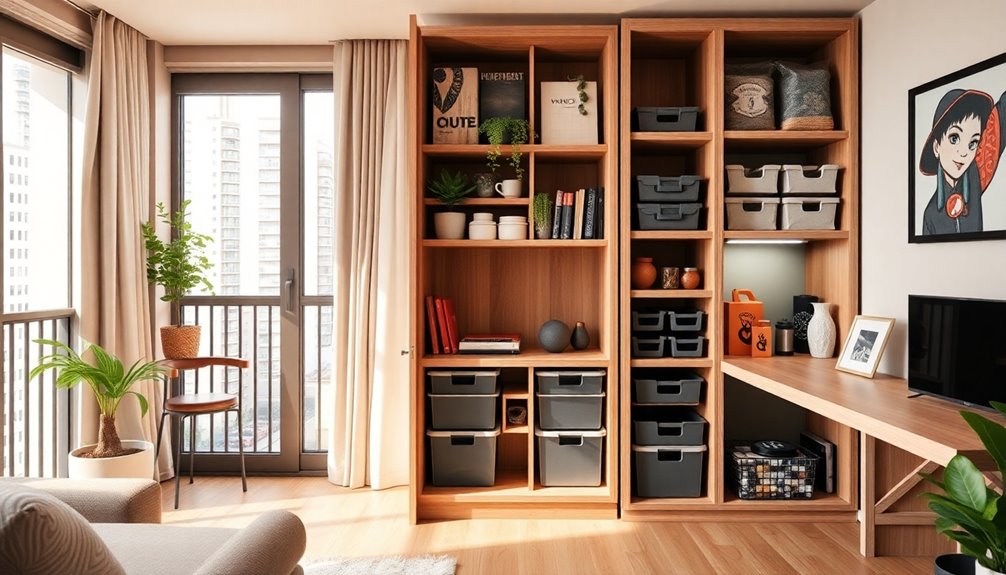
Urban prepping in your apartment can be fun and creative! You can maximize your space by using high shelves for things you don't use often, like holiday decorations. Cute baskets and stackable bins keep things tidy and organized. Multi-functional furniture, like storage ottomans or convertible sofas, helps save room and adds style. Don't forget to fill underutilized spaces, like under your bed or stairs, with hidden storage. Using colorful labels makes finding seasonal items a breeze. Get ready to transform your apartment into a cozy, organized haven where everything has its place! There's so much more to explore!
Key Takeaways
- Maximize vertical space with high shelving units and wall-mounted solutions to store infrequently used items efficiently.
- Utilize multi-functional furniture, like storage ottomans and Murphy beds, to save space while providing additional storage options.
- Implement clear, labeled bins for quick access to seasonal items and keep your space organized.
- Transform underutilized spaces, such as under-stairs areas and corners, into functional storage solutions like cabinets and shelves.
- Regularly declutter and label seasonal items to maintain an organized living space and improve accessibility.
Maximizing Vertical Space
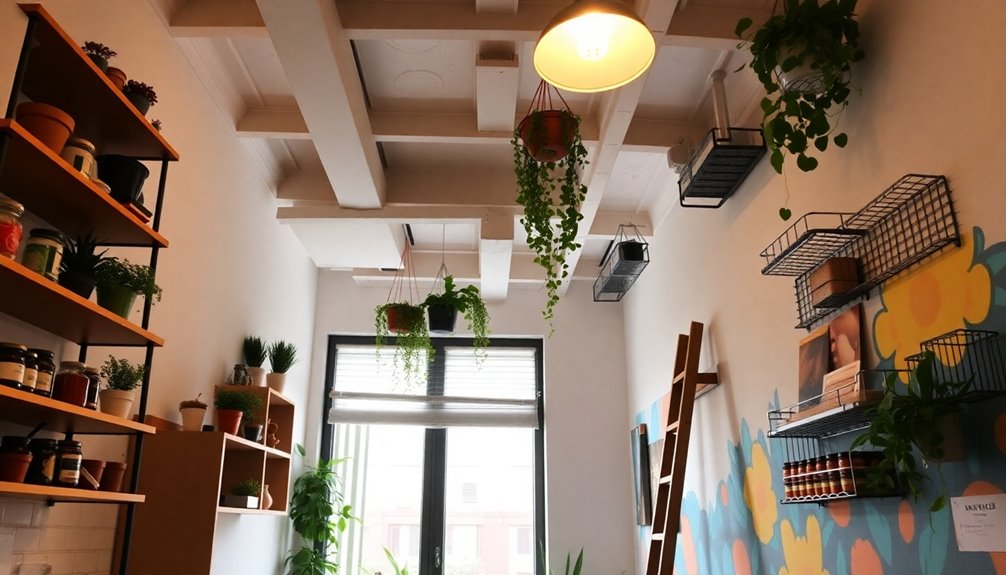
When you maximize vertical space in your apartment, you can release up to 30% more usable storage. Isn't that exciting? Think about how many toys, books, or clothes you can store!
Using high shelving units is a fantastic start for small-space storage. They're perfect for those items you don't use every day, like holiday decorations or extra blankets. Additionally, it's important to consider your dog's needs, as early socialization can lead to well-adjusted pets. Regular interaction with animals can also offer companionship that contributes to emotional well-being. Properly storing items can also prevent them from becoming damaged, similar to how freeze-drying preserves candy. You might even consider using decorative candy containers for added style and functionality.
You can also use decorative baskets on those shelves to keep everything looking neat and colorful.
Wall-mounted solutions, such as pegboards and hooks, are great for organizing tools, kitchen utensils, and bags. They save valuable floor space while keeping your items easy to reach.
Don't forget those hidden storage areas! You can use the space above cabinets or even above door frames. Those spots can hold items while still keeping your home tidy.
And for shoes, over-the-door racks are awesome! They help you store your shoes vertically, making your closet more organized and functional. Additionally, maintaining a clean and organized home can support a healthier lifestyle by promoting cleanliness and hygiene.
Creative Furniture Options

Maximizing vertical space is just the beginning of creating a functional apartment. You can make your living area cozy and clever by choosing creative furniture options. Multi-functional furniture is a great way to save room. For example, a storage ottoman can be a comfy seat and hide your blankets or toys inside!
Another fantastic option is a Murphy bed. It folds up against the wall when you don't need it, giving you extra space to play or relax during the day. Tiny homes, which often feature innovative designs, can inspire similar space-saving solutions in apartments. Understanding the importance of zoning laws can enhance the functionality of your living area. Additionally, incorporating multi-functional furniture can optimize the use of limited space in your apartment.
If you enjoy hosting friends, consider a convertible sofa. It's a comfy couch that turns into a bed for guests at night.
Also, think about window seats with storage. They're perfect for snuggling up with a book while also providing a secret spot to stash your favorite items. Plus, they add charm to your apartment!
Lastly, nesting tables are handy, too! You can stack them away or spread them out when you need extra surfaces for snacks or games. Incorporating furniture that doubles as storage can help promote a clutter-free environment, making your space feel more open and inviting.
Innovative Storage Techniques
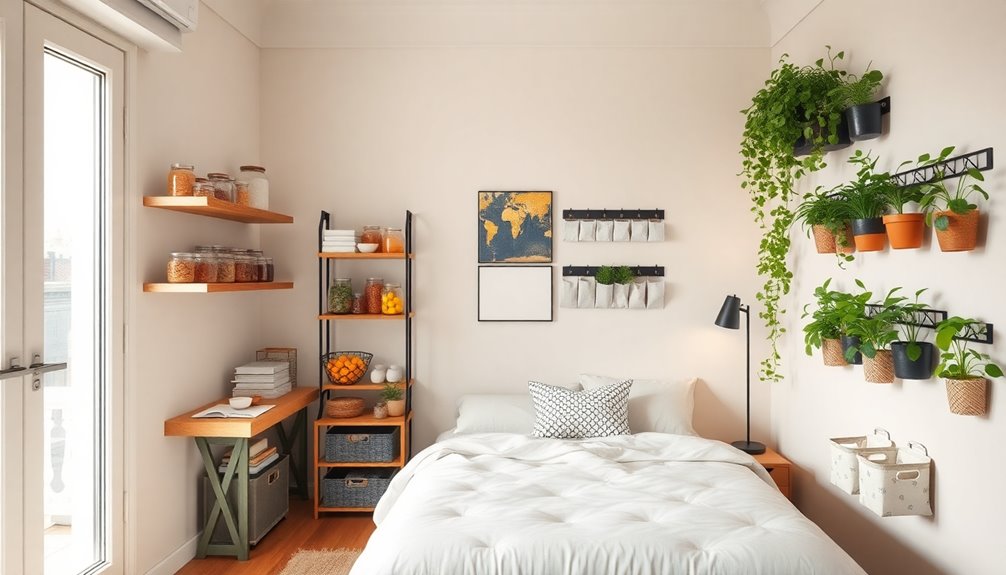
You can easily create more storage space in your small space with a few clever ideas. Here are some fun tips to help you out:
- Wall-mounted Shelves: They keep your floor clear and make it easy to reach your favorite things. Sustainable materials can be used for these shelves to enhance both functionality and eco-friendliness. Utilizing these shelves can also enhance focus and productivity by minimizing distractions in your living area. Additionally, incorporating vertical storage solutions can free up even more floor space for movement and comfort. These shelves can also be made from natural materials, promoting an eco-friendly aesthetic that resonates throughout your apartment.
- Woven Baskets: These can hold various items while adding a stylish touch to your room.
- Under-bed Storage: Use containers for hidden compartments where you can stash seasonal clothes or emergency supplies.
- Hooks and Organizers: Hang them on doors to store coats, bags, and other accessories, turning unused areas into valuable storage options.
Additionally, consider adding open shelving to display your favorite items while maximizing vertical space.
Underutilized Areas for Storage

You mightn't realize it, but there are plenty of spots in your apartment just waiting to be turned into clever storage areas!
Think about the space under your stairs, where you can build shelves or cabinets, and even those sunny windowsills that can hold your favorite plants or cool trinkets. Adding reclaimed wood furniture can also enhance both storage and aesthetic appeal in your living space. To create a calming environment, consider incorporating proper diet principles from pet care, such as using natural materials that promote a sense of well-being. Additionally, incorporating weather-resistant materials in your storage solutions can help ensure durability and functionality. You can also utilize self-watering plant pots on your windowsills, which not only save space but also keep your plants healthy with minimal effort.
Don't forget about corners, which can be perfect for cute little shelves that keep things organized while saving space—let's make the most of every nook and cranny! Additionally, consider incorporating smart bathroom technologies that can help you maximize efficiency and comfort in your living space.
Under-Stairs Storage Options
Under-stairs storage is one of the most overlooked spaces in an apartment, yet it holds immense potential for organization and style.
If you take a peek under your stairs, you might find a treasure trove of possibilities! Here are some fun ideas to make the most of that space:
- Built-in Cabinets: Install cabinets or drawers to neatly store shoes, tools, or household items. They keep everything hidden and tidy! Consider using oak wood for a durable and stylish finish. You can also enhance the aesthetic by incorporating bold colors to create an energetic vibe. Additionally, built-in cabinets can significantly improve storage efficiency by maximizing the use of otherwise wasted space. This approach mirrors the functional decor concept popular in modern farmhouse design.
- Open Shelving: Use shelving units to display books or decorative items. It's a great way to show off your favorite things while keeping them within reach.
- Custom Pull-Out Bins: Design custom pull-out bins or baskets that fit perfectly under the stairs. They're super flexible, perfect for different item sizes.
- Sliding Doors: Add sliding doors or curtains to conceal your under-stairs storage. This keeps things looking clean and blends perfectly with your room's decor.
Additionally, utilizing this space effectively can lead to improved cognitive development skills as it encourages problem-solving and organization.
Windowsill Display Spaces
After maximizing under-stairs storage, don't overlook the potential of your windowsills. These flat surfaces can be perfect little display areas for your favorite plants, colorful decorative items, or even small storage containers. Incorporating mindfulness techniques into your decorating process can help you create a more harmonious and inviting space. Espresso's caffeine content can also provide a boost of energy while you creatively arrange your windowsill decor. Additionally, consider adopting an MVP approach to test different arrangements and styles that resonate with your personal taste.
You'll be amazed at how they can brighten up your room while also giving you extra storage in small spaces! By using decorative baskets or tiered shelves on your windowsill, you can keep everything organized and stylish. Choose shallow containers that fit nicely without overcrowding the space. This way, you keep it looking tidy and cute! Additionally, consider adding educational toys to your windowsill setup, as they can serve as both decor and a fun play option for toddlers.
Plus, the natural light coming through the window is great for growing small plants or herbs, adding both life and visual interest to your home. Don't forget to switch up your decorations with the seasons! Rotating items like holiday decorations or seasonal plants can keep your windowsill dynamic and engaging.
Imagine how delightful it would be to have a fresh look every few months! With just a little creativity, your windowsills can become charming focal points, enhancing both your storage and your apartment's beauty. Additionally, incorporating decorative organization strategies can help maximize your storage potential and maintain a clean aesthetic.
Corner Storage Solutions
Corners in your apartment can often feel neglected, but they hold incredible potential for clever storage solutions.
With a little creativity, you can turn these underutilized spaces into organized havens! Here are some fun ideas to get you started:
- Corner Shelves: Install corner shelves to showcase your favorite books, plants, or fun decorations. They not only save space but also make your room look stylish! Additionally, you can use best air flow ceiling fans to keep the air circulating while you enjoy your newly organized space. Consider that home security systems can also be integrated into your corner setup for added safety and peace of mind. Investing in best vacuum pool cleaners can also help maintain cleanliness in your home, ensuring that your corners remain dust-free. Regularly cleaning air purifiers in nearby areas can further improve the overall air quality and atmosphere of your apartment.
- Corner Cabinets: Choose corner cabinets to hide away cleaning supplies or seasonal decorations. They fit perfectly in tight spots and keep everything tidy.
- Lazy Susans: Add lazy Susans in your corner cabinets or on shelves. They help you reach your favorite snacks or items without having to dig deep!
- Over-the-Door Shoe Racks: Use over-the-door shoe racks to hang bags, hats, or accessories. This way, you free up floor space and keep essentials close by.
Additionally, implementing regular vacuuming in these areas can help maintain cleanliness and prolong the life of your carpets.
Seasonal Storage Strategies
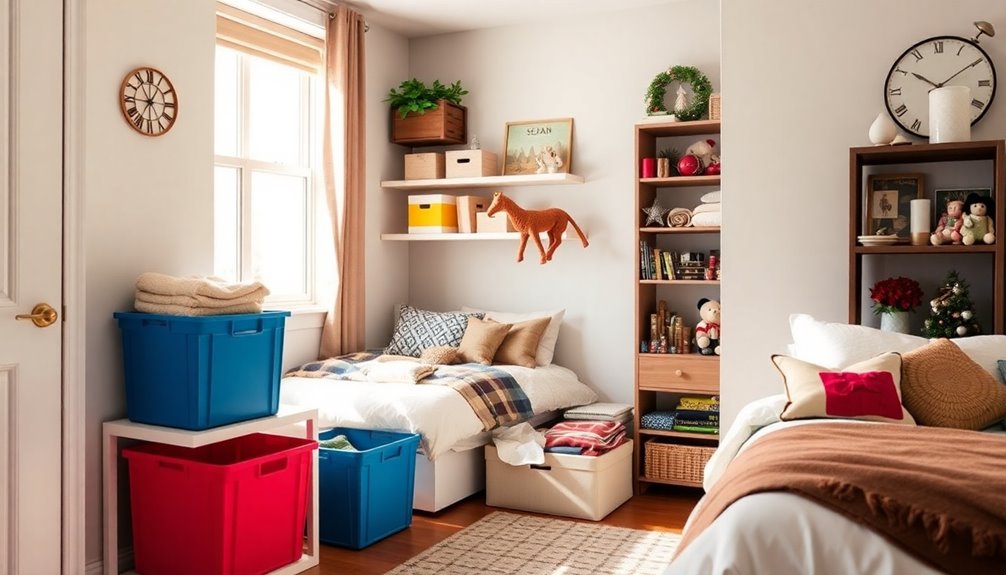
When it's time to switch out your seasonal items, it can feel like a fun treasure hunt in your own home!
By using clear, labeled bins, you can quickly find your favorite summer shorts or cozy winter blankets without digging through piles of stuff. Additionally, proper appliance maintenance can help keep your seasonal storage solutions functioning optimally throughout the year. It's also beneficial to maintain high vibrational energy during this process, as it can enhance your overall experience and satisfaction with your living space. Moreover, implementing energy-efficient technology in your home can significantly reduce energy costs while keeping your apartment comfortable throughout the seasons. Incorporating Montessori Toys into your seasonal storage can encourage ongoing learning and creativity for your children throughout the year.
Plus, rotating your decorations and clothes at specific times of the year helps keep everything fresh and organized, making your apartment feel super inviting! Additionally, incorporating energy-efficient designs can help you save space and maintain comfort throughout the seasons.
Rotating Seasonal Items
Managing seasonal items in an apartment can feel like a juggling act, but with the right strategies, you can keep your space organized and clutter-free.
By identifying your seasonal items, like winter clothes or holiday decorations, you can create a smoother storage experience. Here are four fun tips to help you rotate those items:
- Use Vacuum-Sealed Bags: These bags shrink your clothes and bedding, saving space and keeping them safe from moisture and pests. Consider using energy-efficient options for your vacuum to minimize power consumption while storing. Additionally, utilizing intelligent water level detection in your vacuum can help ensure you're using the right amount of water for cleaning. Regularly cleaning and maintaining your air purifier filters can also enhance air quality in your storage area.
- Schedule Swap Dates: Plan regular times to swap out your seasonal items, like during equinoxes. This keeps everything organized and prevents clutter.
- Under-Bed Containers: Store off-season items in these nifty containers. They fit perfectly under your bed, so you can use that space wisely!
- Digital Inventory Management: Keep a list of your seasonal items and their storage areas. This way, you'll know exactly where everything is and will make swapping a breeze.
Additionally, consider using reflective gear during winter months for better visibility if you plan to bike in low-light conditions.
With these strategies, small-space living becomes more manageable, and you'll always be ready for the next season!
Labeling for Easy Access
After you've rotated your seasonal items, it's time to focus on how to keep them organized for easy access. Labeling for easy access is super important, especially in a small apartment where space storage can be tricky.
Try using a color-coded labeling system for your storage unit. This way, you can spot what you need at a glance, like winter gear or holiday decorations.
Make sure to use waterproof labels or markers, since seasonal items might be stored in damp areas. You wouldn't want your labels to get all messy!
It's also a great idea to keep a digital inventory list that matches your labeled bins. This will help you remember where everything is stored, making it easy to find your seasonal supplies.
When you label your bins, clearly mark them by category. This will help you quickly grab what you need during seasonal changes, without clutter or confusion.
Don't forget to update your labels and inventory list when you add or remove items. Keeping everything organized will make your life so much easier! Happy organizing!
Space-Saving Storage Bins
Finding the right space-saving storage bins can make all the difference in keeping your seasonal items organized and accessible. When you choose the right bins, you can enjoy a tidier space!
Here are some great options:
- Stackable Bins: These bins are perfect for maximizing vertical space. You can easily stack them in closets or under beds, making the most of your limited floor space.
- Clear Containers: Clear storage bins help you see what's inside at a glance. This way, you won't waste time searching for holiday decorations or seasonal clothes!
- Vacuum-Sealed Bags: Use vacuum-sealed bags for clothes and bedding. They shrink down your items, so you can store them easily under your bed or in closets, while also protecting them from moisture and pests.
- Storage Cubes: These handy cubes can fit in various nooks and crannies. They're great for keeping smaller items organized, like scarves or gloves.
Aesthetic Enhancements for Functionality

Transforming your apartment into a stylish yet functional space is easier than you might think. By incorporating aesthetic enhancements, you can create storage solutions that look great and serve a purpose. For instance, using vintage suitcases or decorative boxes adds character while keeping your belongings organized.
Woven baskets are another fantastic choice; they help tidy up your space and add texture and color. You can even beautify your radiators with wooden shelves for extra display space, making those overlooked areas shine.
Want to bring some life into your small space? Integrate plants! Use door molding to create small plant displays that won't take up any floor area. Opt for decorative containers that blend with your decor too. They can effectively hide everyday items while keeping everything looking cohesive and beautiful.
Here's a handy table to inspire you:
| Storage Item | Aesthetic Benefit | Dual Purpose |
|---|---|---|
| Vintage Suitcases | Adds character | Storage & decor |
| Woven Baskets | Texture & color | Organizing & display |
| Wooden Shelves | Chic display | Beautify radiators |
With these ideas, you'll have a cozy, stylish home in no time!
Unique Storage Solutions
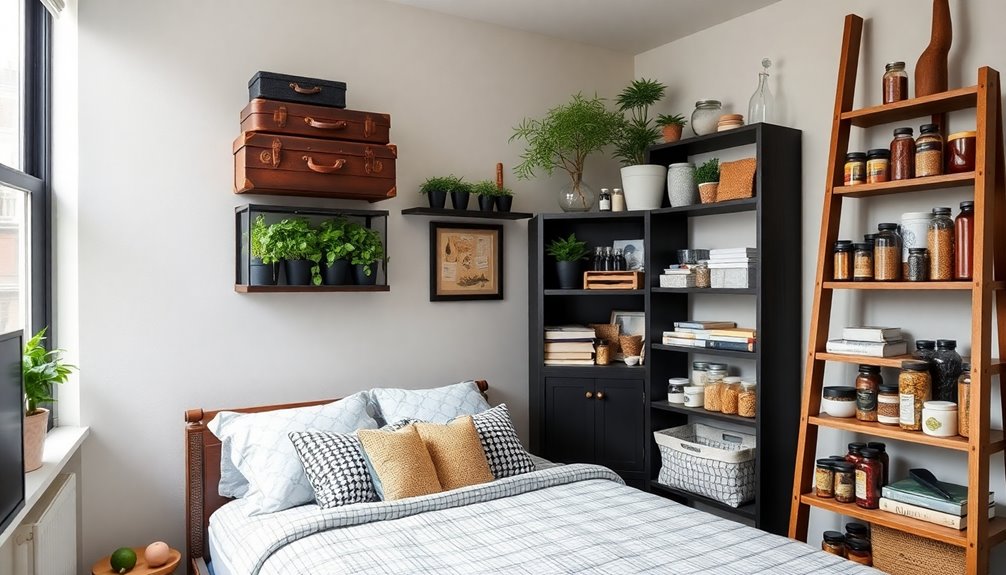
Maximizing storage in a small apartment can feel like solving a puzzle, but unique solutions are all around you. You can create space for prepping food and water while keeping your home organized.
Here are four fun ideas to contemplate using:
- Under-Stairs Storage: Don't let that empty space go to waste! Add shelves or drawers under your stairs for extra storage.
- Vertical Shoe Storage: Use over-the-door shoe racks or wall-mounted organizers. They'll keep your shoes stylishly stored and save floor space.
- Repurposed Vintage Items: Get creative! Use vintage crates, suitcases, or wooden ladders as storage that adds charm to your small house.
- Hidden Storage in Furniture: Look for furniture with built-in storage, like coffee tables or ottomans with secret compartments. They keep your areas tidy and maximize space.
These unique storage solutions are perfect for any small apartment.
With a little creativity, you can make every nook and cranny count! So, go ahead and start transforming your space into a more organized and inviting home.
You'll be amazed at what you can achieve!
Frequently Asked Questions
How Do You Store Things in an Apartment With No Storage?
If you've got an apartment with no storage, don't worry! You can use vertical space by adding high shelves.
Multi-functional furniture, like ottomans with hidden compartments, is super helpful too!
Look under your bed for flat containers or drawers to stash away seasonal items.
Over-the-door organizers are great for shoes and accessories.
Just remember to declutter often, so you can find what you need easily and keep your space tidy!
How to Make Storage Space in an Apartment?
Imagine your apartment is a treasure chest waiting to be filled! To make more storage space, you can use high shelves and wall hooks, which help you reach for your favorite things without cluttering the floor.
Multi-functional furniture, like ottomans with hidden storage, works wonders, too! Don't forget under-bed bins and over-the-door organizers.
Regularly decluttering keeps your space tidy, so you can find what you need easily. Happy organizing!
How Do I Become a Prepper in My Apartment?
To become a prepper in your apartment, start by checking for hidden storage spots. You can use under beds or above cabinets!
Consider getting some cool multi-functional furniture, like a storage ottoman, to keep things tidy. Organize your supplies on wall-mounted shelves, so they're easy to grab.
Don't forget to rotate your food and water regularly to keep everything fresh. With these tips, prepping in your apartment can be fun and smart!
How to Prep With Limited Space?
When you're prepping with limited space, it's all about being clever!
Start by using vertical space—install shelves and hooks on your walls. Multi-functional furniture is your friend, like storage ottomans that can hold blankets and books.
Don't forget under-bed storage! Flat bins can hide your seasonal items.
Finally, keep your closet organized with slim hangers.
It's fun to find smart ways to store your stuff while keeping everything neat and tidy!
Conclusion
By using these apartment-friendly storage solutions, you can turn your home into a cozy, organized space! Did you know that 30% of people feel stressed because of clutter? That's a lot! But with clever ideas like maximizing vertical space and finding hidden storage spots, you can keep everything neat and tidy. So, get creative, have fun, and make your apartment a place you love coming home to! Happy organizing!
Survivalism
Essential Medical Skills for Long-Term Survival
Cultivating essential medical skills is crucial for long-term survival; discover how to equip yourself for unexpected challenges and stay safe in any situation.
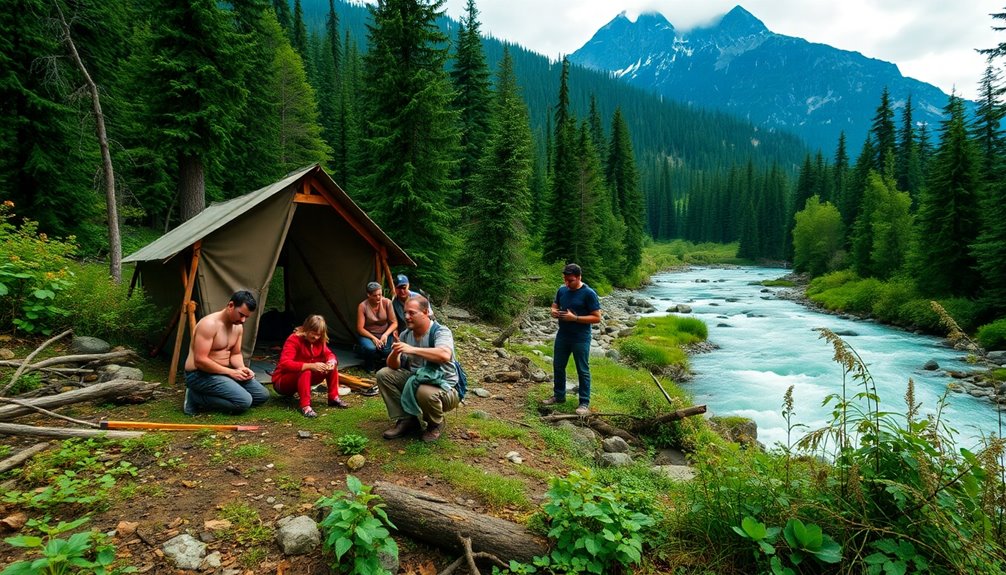
To thrive in tough situations, you need essential medical skills! First-aid basics, like knowing how to clean cuts and burns, are super important. It's crucial to have a first-aid kit with supplies like bandages and antiseptic wipes. Learning CPR can save lives during emergencies, so keep practicing those hands-only compressions! Don't forget about safe water, either; boiling it helps get rid of germs. Managing your hygiene and keeping an eye on your health are also key. Overall, understanding these skills can boost your confidence and prepare you for any adventure ahead. Stick around, and you'll discover even more helpful tips!
Key Takeaways
- Master basic first-aid skills, including wound care, to effectively manage injuries and reduce infection risks during emergencies.
- Learn CPR techniques to significantly increase survival chances in cardiac arrest situations; act quickly within 3 to 5 minutes.
- Acquire knowledge in managing burns and cuts, using appropriate cooling and cleaning methods to promote healing.
- Understand water purification methods, such as boiling or filtering, to ensure safe drinking water in survival scenarios.
- Develop emotional preparedness and financial planning strategies to support long-term recovery and stability in crisis situations.
Importance of First-Aid Skills

First-aid skills are essential for anyone venturing into the wilderness. You never know when a medical emergency might happen! Knowing basic first aid skills can really boost your confidence and help you handle tricky situations. Imagine you're hiking, and a friend gets a cut. If you can stop the bleeding quickly, you might just save a life!
When you're out in nature, it's super important to be prepared. Medical emergencies are the second most common reason people find themselves in survival situations, right after getting lost. Learning basic techniques like CPR and wound management can make a big difference. Additionally, knowing how to properly handle tick removal from pets can be crucial if your furry friends accompany you on your adventure, as tick removal is essential to prevent illness. With practice, you can turn a scary situation into something you can manage. Additionally, having portable camping toilets on hand can help maintain hygiene during emergencies, as inadequate hygiene can lead to financial implications in terms of medical costs. Early intervention, such as performing mammography screening, can also be crucial in identifying serious health issues before they escalate. Furthermore, understanding self-care routines is vital for maintaining your well-being during stressful situations.
Wilderness medicine training teaches you how to respond when you're alone or if a buddy needs help. Mastering these skills keeps you and your friends safe, allowing everyone to enjoy the adventure together.
Basic First-Aid Kit Essentials
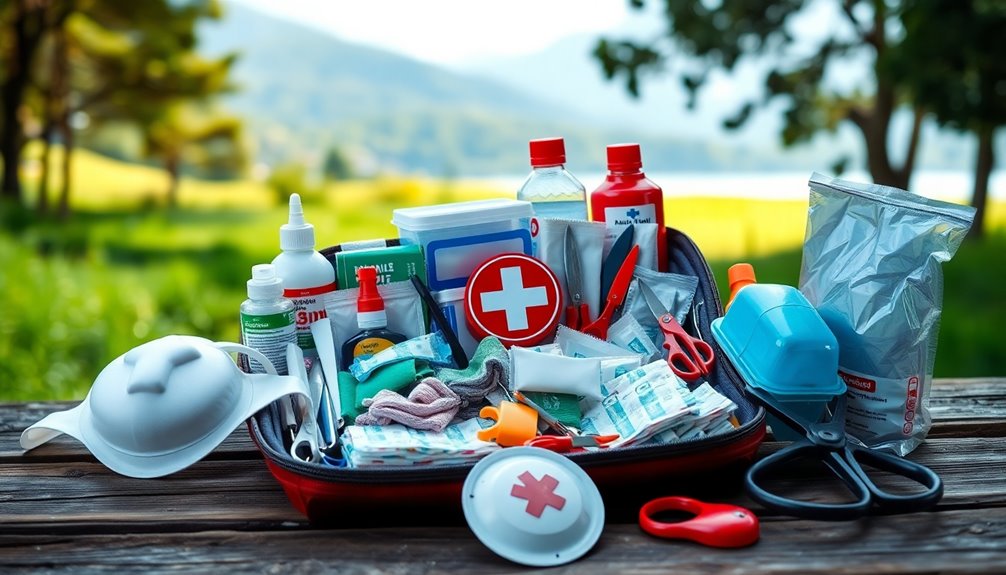
A well-stocked first-aid kit can make all the difference in an emergency. You never know when you might need it, so let's make sure you have all the essentials! Having a comprehensive first-aid kit is only part of being prepared for unforeseen situations. It’s equally important to think beyond immediate medical needs and ensure you’re ready for extended emergencies by learning the best emergency food storage methods. Proper food storage not only provides sustenance but also helps maintain the nutritional value and safety of supplies during critical times.
Start with sterile gauze to help cover wounds and adhesive bandages in different sizes for those pesky scrapes. Antiseptic wipes or solution are essential too; they'll help clean cuts and prevent infection. Don't forget medical tape to hold everything in place! It's also important to be aware of the signs of newborn distress when caring for infants.
If someone's bleeding badly, a tourniquet can help you stop the bleed until help arrives. A splint is also handy for any broken bones. You'll want pain relievers like ibuprofen or acetaminophen for those ouchies! Always keep in mind that certain medications may be unsafe for specific pets if used around them. Keeping a well-stocked first-aid kit can help ensure you have essential medical supplies during emergencies. Additionally, having a first-aid kit equipped with HEPA filtration can be beneficial for maintaining a clean environment, especially for allergy sufferers.
Tweezers are great for removing splinters or ticks, and a CPR mask is a must for rescue breathing in emergencies. Additionally, knowing how to provide effective first aid can significantly improve outcomes in critical situations.
Make sure to check your basic first-aid kit regularly and replace any used items. Consider keeping smaller kits in different places, so you'll always have quick access. A handy manual or guide can help you remember what to do during emergencies.
With these supplies, you can be ready for anything—stay safe and have fun!
Managing Burns and Cuts
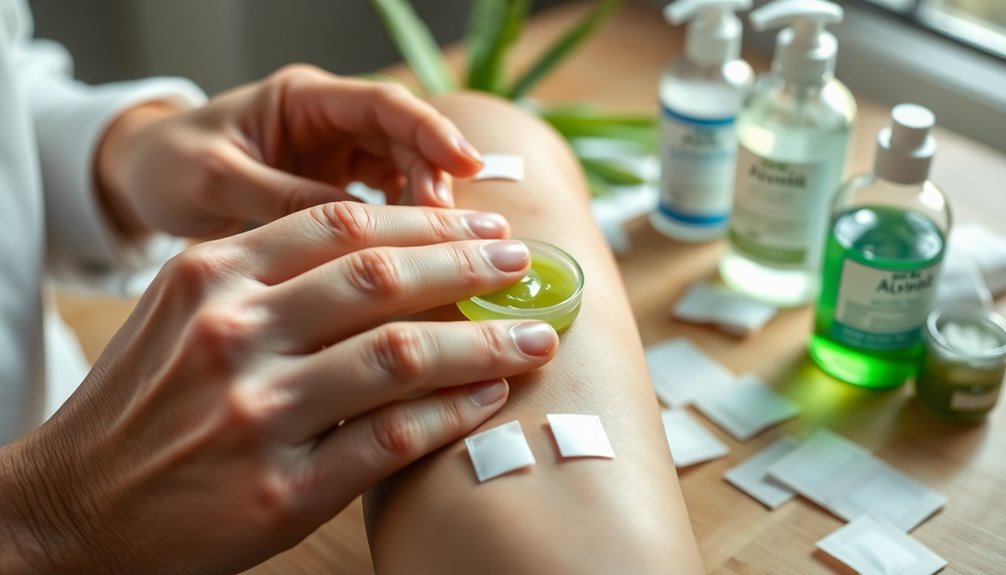
Burns and cuts can happen when you least expect it, so knowing how to manage them is essential. When you get a burn, quickly cool it under running water for at least 10 minutes. Remember, never put ice directly on it! For cuts, wash the wound with soap and water, then apply antiseptic and cover it with a sterile bandage. Keeping the wounds clean and properly maintained is crucial for preventing complications, especially in healthcare facilities where strict hygiene protocols are essential. Additionally, using air purifiers can help improve indoor air quality, which may further reduce the risk of infections. It's also important to educate children about proper oral hygiene since poor dental health can lead to further complications. Regularly checking for signs of infection can ensure timely medical intervention if necessary. Keep an eye on your cuts, changing the dressing regularly to make sure the bleeding stops and there are no signs of infection. Additionally, using natural remedies like turmeric's anti-inflammatory properties can support the healing process.
Here's a quick reference table to help you remember how to manage burns and cuts:
| Type of Injury | Management Steps |
|---|---|
| First-Degree Burn | Cool with running water, apply ointment |
| Second-Degree Burn | Cool for 10 minutes, cover with dressing |
| Cut/Laceration | Clean, apply antiseptic, cover with bandage |
| Signs of Infection | Seek medical attention if redness or pus appears |
Proper wound management is key for healing and minimizing complications. If a burn or cut seems serious or isn't healing, don't hesitate to get medical attention. You got this!
Wound Packing Techniques

When you're faced with a wound that's bleeding heavily, knowing how to pack it properly can make a big difference! You'll want to use the right materials and follow the steps carefully to help stop the bleeding. It's also important to be aware of common symptoms of conditions that may require wound care to ensure comprehensive treatment. Additionally, understanding the impact of cognitive decline can help you recognize when a loved one may not communicate their need for care effectively. It's crucial to remember that legal separation is often seen as an alternative to divorce in certain situations. Maintaining emotional alignment during stressful situations can also help you respond more effectively. Knowing the importance of immediate first aid can further enhance your ability to manage wounds effectively. Let's explore the types of wounds you might encounter, the packing materials you'll need, and how to apply them effectively!
Types of Wounds
Understanding wound packing techniques is essential for effectively managing severe bleeding in various types of wounds. When someone gets hurt, knowing how to control bleeding can make a big difference!
Here are some important points to remember:
- Power Ball Technique: This method involves tightly packing gauze into the wound to create internal pressure. It helps a lot with big injuries where direct pressure mightn't work. Additionally, using essential oils for pain relief can complement wound management by alleviating discomfort. Research has shown that essential oils can also provide antibacterial properties, which may help reduce the risk of infection. In fact, mediation services are widely available to assist in conflict resolution during medical emergencies. Proper wound care is crucial for preventing infection risks that can complicate recovery.
- Areas to Avoid: Don't use the power ball technique in the lower abdomen or collarbone. Instead, use chest seals for those spots.
- Pressure Matters: When you're packing a wound, it's super important to maintain pressure for at least 30 minutes. This helps control bleeding and lowers the risk of shock.
- Seek Medical Help: After managing the bleeding, always check for signs of infection and get professional medical attention as soon as you can. Additionally, incorporating music therapy into recovery can help manage stress and promote healing.
Packing Materials Required
Packing a wound effectively requires the right materials to guarantee ideal control of bleeding and promote healing.
You'll need sterile gauze or special hemostatic dressings for effective wound packing. These materials help fill deep wounds, providing internal pressure to stop bleeding. For larger wounds, try the power ball technique, which creates a tight, compressive ball of gauze. Just remember, don't use it in the lower abdomen or collarbone area! Additionally, using ethical hacking techniques can help in applying a systematic approach to ensuring the wound is properly managed. Regularly checking for pet-specific sprays may also help in maintaining a clean environment post-injury. It is essential to understand that proper disposal practices can prevent contamination and promote healing.
When you pack a wound, make certain the material is tightly packed. This helps absorb drainage and promotes clotting while lowering the risk of infection.
After packing, it's crucial to apply pressure for at least 30 minutes to make certain the bleeding stops. Keep an eye out for any signs of continued bleeding, as this could mean you need more help. Additionally, maintaining a high vibrational energy can be beneficial in promoting overall well-being and resilience during injury recovery.
Application Steps Explained
To effectively pack a wound, start by gathering your sterile gauze and any necessary tools. Wound packing is important for deep wounds where direct pressure isn't enough. Here's how to do it safely and effectively:
- Form a Ball: Use the "power ball technique" by rolling the gauze into a tight ball and gently packing it into the wound.
- Apply Pressure: Push down firmly to create internal pressure and absorb any drainage. This helps stop the bleeding, and early detection of complications can further improve outcomes. Proper wound care techniques can significantly reduce the risk of infection and promote healing. It's essential to remember that using a tourniquet may also be necessary prior to packing in severe cases. Additionally, maintaining a consistent routine during recovery can support emotional well-being.
- Dress It Up: Always cover the packed wound with a dressing. This stabilizes everything and keeps germs out.
- Keep an Eye Out: Monitor for signs of infection. Change the dressing regularly, looking for any redness, swelling, or extra drainage.
If you used a tourniquet before packing, don't remove it until professional medical help arrives. Removing it too soon could cause serious blood loss. Additionally, using methods like sugardine healing can help promote recovery and prevent infections in packed wounds.
CPR and Emergency Response
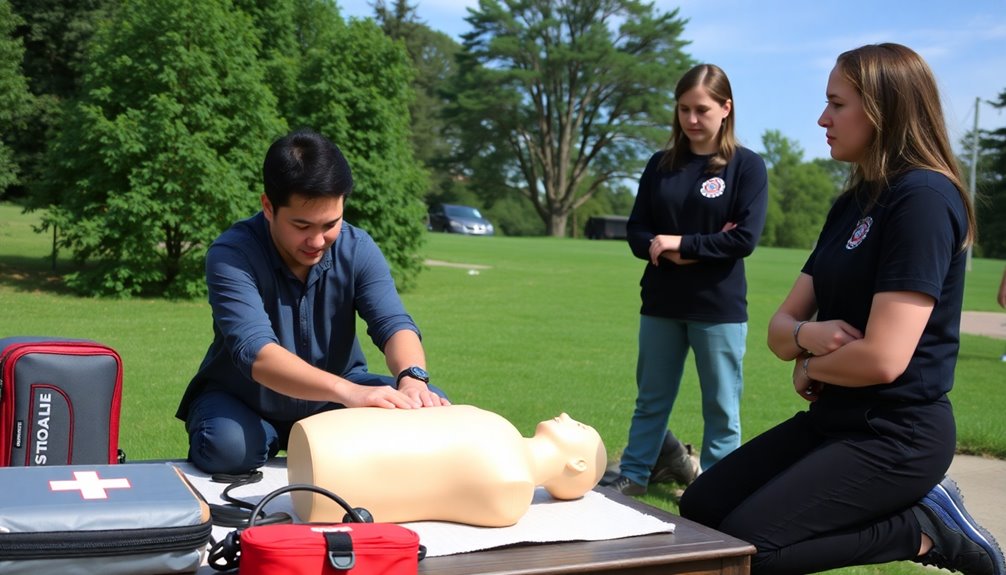
When a cardiac emergency strikes, knowing CPR can mean the difference between life and death. CPR, or cardiopulmonary resuscitation, is a life-saving technique that can double or even triple someone's chances of survival during a cardiac arrest. The American Heart Association says that if you perform CPR within 3 to 5 minutes, you can make a huge difference for that person. Additionally, being aware of financial planning during emergencies can help ensure you have the necessary resources for medical care. Understanding that ethical hackers often simulate emergency scenarios can also provide insights into how to better prepare for crises. It's also vital to consider how to create a retirement savings plan to ensure financial stability throughout life, including during health emergencies.
For those who aren't trained, hands-only CPR is the best option. All you need to do is push hard and fast in the center of the chest, aiming for 100 to 120 compressions per minute. It's simple, and it keeps blood flowing until medical attention arrives. Understanding the critical periods for skill acquisition can also enhance your ability to learn life-saving techniques effectively.
You can easily learn CPR through organizations like the Red Cross. They offer fun and engaging courses both in-person and online, so you can be ready for any survival situation. In addition, being aware of how to recognize unusual breast changes can also be crucial in early detection for men at risk of breast cancer.
Knowing CPR not only helps you respond effectively in emergencies, but it also makes your whole community safer and better prepared. So, take some time to learn this important skill – you might just save a life someday!
Water Safety and Purification
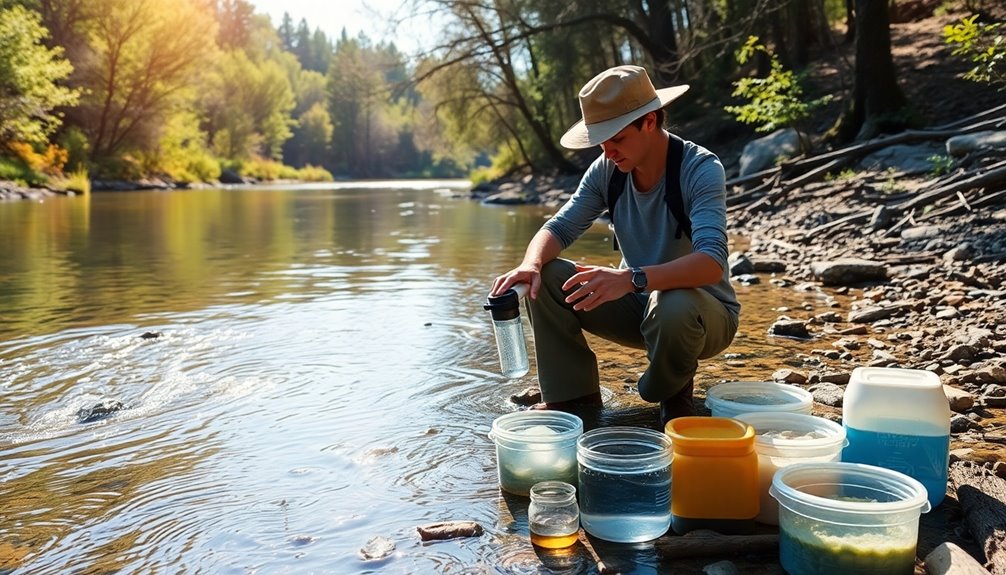
In emergencies, having access to safe drinking water is as essential as knowing CPR. You need to be aware of water safety and purification to stay healthy.
In survival situations, drinking contaminated water can lead to serious health issues, and you don't want that! Here are some easy tips to guarantee your water is safe:
- Find Safe Sources: Look for flowing streams or springs. They're usually cleaner than still water, especially when considering seasonal variations that may affect water quality. Additionally, remember that decentralized control over local water sources can enhance community resilience in emergencies. It's also important to note that exposed beams in shelters can help create a safer environment by improving ventilation. Furthermore, always prioritize natural beauty in your surroundings, as it often signifies healthier ecosystems.
- Boil Your Water: Boiling water for at least one minute kills harmful germs, making it safe to drink.
- Use Purification Methods: Consider using filters or chemical treatments, like iodine or chlorine tablets, to make certain your water is free from bacteria and viruses.
- Watch for Contamination: Always check your water for odd colors or smells. If it looks funny, don't drink it!
Additionally, understanding color accuracy in home cinema projectors can help ensure that water purification methods are displayed clearly and effectively in instructional videos.
Foraging and Food Acquisition
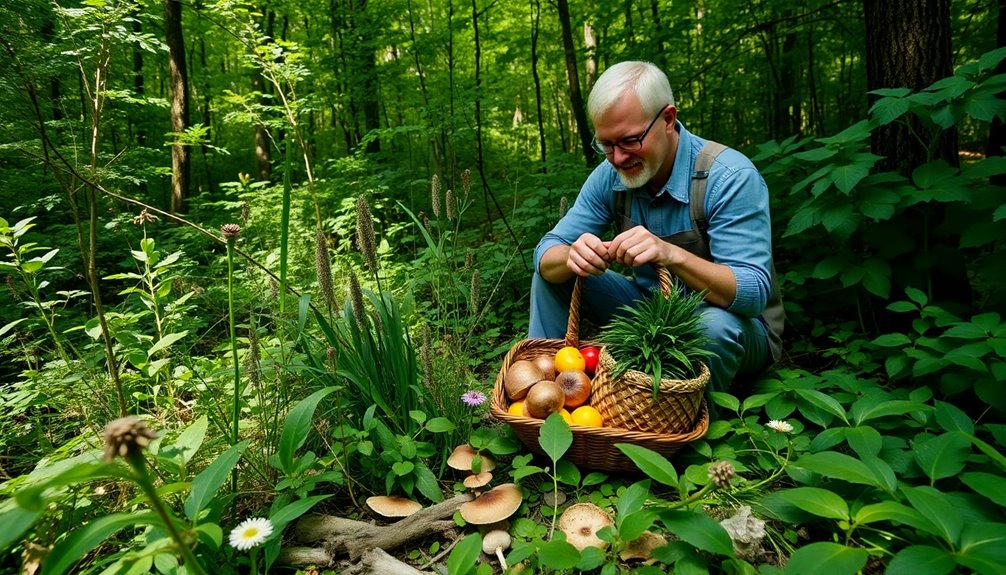
Foraging and food acquisition are essential skills that can mean the difference between survival and starvation in the wild. Imagine being out in nature, exploring the great outdoors, and discovering delicious edible plants! Knowing what to look for, like dandelion leaves, wild blueberries, and clover, can provide the nutrients you need to stay strong.
To be a successful forager, you should understand when certain plants are in season. Some might only be tasty at certain times of the year, so keep an eye on the calendar!
And remember, not all plants are safe to eat—poison ivy and hemlock can be dangerous, so always check a reliable guide before munching on unknown greenery.
But foraging isn't just about plants! You can also look for animal tracks and signs to help with food acquisition. This knowledge can lead you to successful hunting or trapping opportunities.
Practicing these skills can really boost your chances of finding food in a survival situation. So, get outside, explore your local ecosystem, and have fun learning about the edible wonders that nature has to offer!
Navigation and Signaling Skills

Getting around in the wilderness can be an exciting adventure, and knowing how to use a compass is a great start!
You'll also learn some cool celestial navigation tricks to find your way using the sun and stars.
Plus, we'll talk about how to signal for help so that rescuers can find you when you need it most!
Compass Usage Techniques
A compass is an essential tool for anyone traversing the wilderness or unfamiliar terrain. It helps you find your way and is a key part of basic skills for wilderness survival.
To use a compass effectively, follow these steps:
- Hold it level: Keep the compass flat in front of you.
- Align the needle: Rotate the housing until the orienting arrow lines up with the magnetic needle.
- Follow the arrow: Move in the direction indicated by the travel arrow.
- Account for declination: Remember that magnetic north isn't always true north, so adjust accordingly.
Using a compass with a map is super helpful! By spotting landmarks and triangulating your position, you can navigate confidently.
The more you practice these techniques in different environments, the better you'll get. Soon, reading a compass will become second nature, making your wilderness adventures safer and more fun.
Celestial Navigation Methods
When you're in the wilderness without a compass or GPS, celestial navigation becomes a valuable skill. You can use the sun, moon, and stars to find your way! The North Star, or Polaris, is especially helpful because it points directly to true north. By using a sextant or similar tool, you can measure the angle between the horizon and a celestial body to calculate your latitude accurately. It's like a treasure map in the sky!
Here's a quick look at celestial navigation basics:
| Celestial Body | Key Information | How to Use It |
|---|---|---|
| North Star | Directly above the North Pole | Find true north easily |
| Sun | Rises in the east, sets in the west | Use its position for direction |
| Moon | Changes position nightly | Helps with night navigation |
| Stars | Different constellations visible | Can guide you with patterns |
| Declination | Angle to the celestial equator | Important for long distances |
Signaling for Rescue
Signaling for rescue can make all the difference in a survival situation. When you're in trouble, it's important to get noticed quickly! Here are some cool ways to signal for rescue that can boost your chances of survival, as suggested by the Red Cross:
- Use Reflective Surfaces: Mirrors or shiny metal can catch the sunlight and attract attention from above. It's like sending a shiny message!
- Create SOS Signs: You can gather natural materials or even use your clothing to spell out SOS on the ground. Big, bold letters are easier for rescuers to see from the sky.
- Smoke Signals: If it's getting dark, controlled fires can produce smoke signals. They look great against the night sky and let nearby rescuers know you need help.
- Practice Morse Code: Learning Morse code lets you send out signals using light or sound. It's like having your secret language for emergencies!
Being prepared with these signaling skills can really help you in potentially life-threatening situations.
Frequently Asked Questions
What Are the Five Most Important Survival Skills?
When it comes to survival skills, you'll want to know five key things!
First, building a shelter keeps you safe from the elements.
Next, finding clean water is super important to stay hydrated.
Then, knowing how to start a fire helps you cook food and stay warm.
Don't forget about foraging for edible plants, too!
What Are Survivability Abilities?
Have you ever watched a superhero movie and thought about what makes someone truly heroic?
Survivability abilities are those awesome skills that help you thrive in tough situations! They include knowing how to find clean water, building a shelter, and providing first aid when needed.
You'll also learn to navigate using nature, so you never feel lost. Mastering these skills not only boosts your confidence but also keeps you safe and sound!
What Are Some Basic First Aid Skills Everyone Should Know?
Everyone should know some basic first aid skills!
First, you can clean and dress wounds to keep them from getting infected.
If someone looks pale or feels weak, they might be in shock, so help them sit down and keep them warm.
If a person stops breathing, you can perform CPR to save them.
Finally, learn how to control bleeding by applying pressure or using a tourniquet.
These skills can really make a difference!
What Are Survival Skills Called?
Imagine you're a brave explorer, ready to conquer the wild!
Survival skills, often called "wilderness survival skills," are the magical tools you'll need. They include techniques for finding food, building shelters, and even maneuvering through tricky paths.
With these skills, you can turn a scary situation into an exciting adventure! Mastering them helps you feel confident and ready for anything nature throws your way, making every outdoor experience unforgettable and safe!
Conclusion
In the grand adventure of life, knowing essential medical skills can be your shining armor! With a little practice, you can handle bumps, scrapes, and surprises like a pro. Remember, every skill you learn adds to your treasure chest of knowledge, making you ready for anything. So grab that first-aid kit, splash some water on your plans, and navigate your way to safety. You've got this! Embrace the journey and be the hero in your own story!
Survivalism
How to Build a Solar-Powered Off-Grid Water System
Build a sustainable solar-powered off-grid water system to enjoy fresh water anytime, but discover the crucial steps to ensure its success!

To build a solar-powered off-grid water system, start by choosing a reliable water source like a well, rainwater, or a nearby stream. Next, install a solar-powered pump to move the water into storage tanks. Make sure your storage is large, like a big cistern, to hold plenty of water when you need it. Regularly check your solar panels and pump for any issues. It's also important to test your water quality to keep it safe. With just a few steps, you'll be on your way to enjoying fresh water anytime you want! There's much more to discover!
Key Takeaways
- Assess your water supply sources, such as wells or rainwater harvesting, to determine the best option for your needs.
- Install solar panels with an MPPT controller to optimize pump efficiency and enhance water delivery.
- Choose appropriate storage solutions, like cisterns or rain barrels, ensuring they are durable and properly sized for your household needs.
- Implement a reliable pump system capable of reaching your water source depth, monitoring for leaks and maintenance regularly.
- Regularly test water quality and inspect solar components to ensure ongoing efficiency and safety in your off-grid water system.
Importance of Off-Grid Water Systems
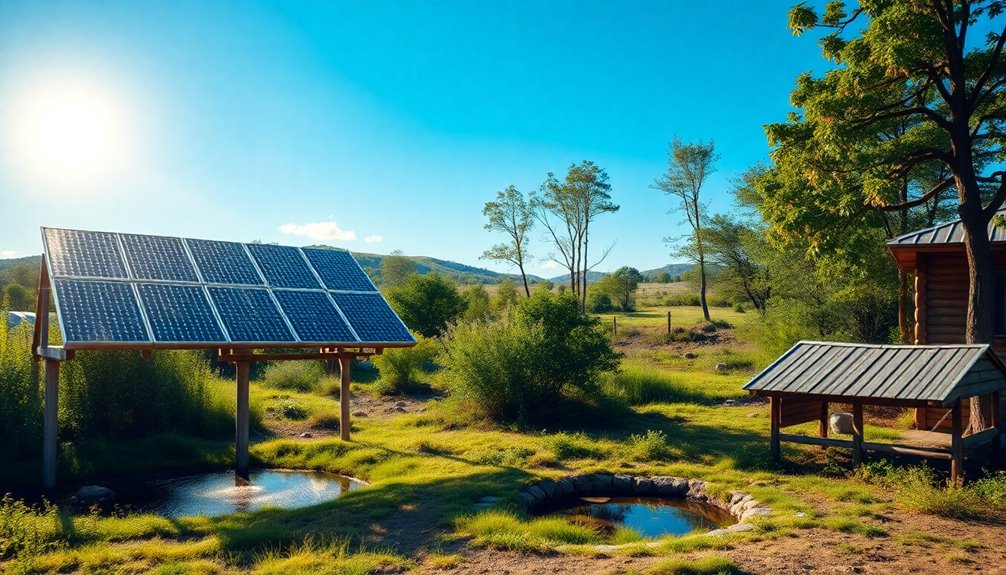
Off-grid water systems play an essential role for homesteaders, especially those without access to municipal supplies. These systems help you become self-sufficient and save money over time. Imagine having your very own reliable water source right at home! You can collect rainwater using a rainwater catchment system, which isn't only fun but also helps the environment!
Having multiple water sources, like groundwater and surface water, makes your setup even stronger. It's like having a backup plan in case one source runs dry. When you store water properly, you can easily tackle your daily needs, which is especially important since the average person uses 80-100 gallons every day. Systems that incorporate renewable energy sources can significantly enhance water system sustainability and efficiency. Using solar-powered solutions can help power pumps and filtration systems, increasing your water supply reliability. Additionally, utilizing wood as a renewable resource for heating during colder months can complement your off-grid lifestyle.
Moreover, establishing a reliable water source can enhance business credibility and ensure you have a consistent supply for all your needs. Setting up off-grid water systems takes some time and effort, but it's worth it. You'll learn about different ways to store water and keep it flowing smoothly.
Plus, you'll feel proud knowing you're taking care of your own water needs. So, jump in and start planning your off-grid water adventure! You'll enjoy the satisfaction of having a reliable water supply while connecting with nature and living sustainably. Additionally, utilizing solar energy solutions can enhance the efficiency of your water system by powering pumps and filtration units.
Selecting Water Supply Sources
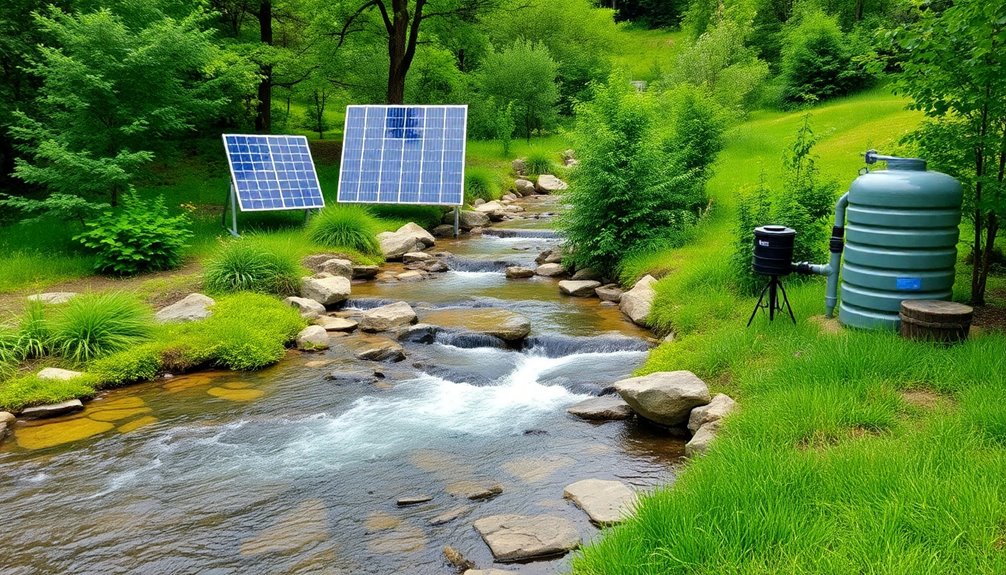
Choosing the right water supply source is essential for creating an efficient off-grid system. You have some great options to evaluate! This decision depends on factors such as location, water availability, and sustainability. Whether you’re considering a well, rainwater harvesting, or a nearby stream, ensure the source is reliable and capable of meeting your needs year-round. Pairing your water system with the best generators for preppers can provide an added layer of energy reliability, ensuring pumps and purification systems run seamlessly even in challenging situations.
Wells are one choice. They can tap into groundwater at depths ranging from 20 to over 300 feet. While they might cost a bit to install, they give you a steady water supply, even when seasons change. Additionally, sustainable harvesting practices can help ensure that your well water remains abundant and clean over time. Consider the importance of diversification in your water sources to reduce the risk of supply shortages. In New England, the diverse environments often contribute to the quality and availability of well water. Proper water quality testing is essential to confirm that your well water is safe for consumption.
Another fun option is rainwater harvesting! You can collect about 0.62 gallons of water for every square foot of roof space per inch of rain. This means you can store up water during wet months and use it later when it's dry.
Don't forget about natural springs! These can give you immediate access to fresh water, but it's super important to check the water quality and any legal permissions first.
Rivers, lakes, and ponds can also be helpful, but they can change with the seasons.
To make sure you always have water, think about using a mix of these sources. That way, your off-grid system stays reliable and sustainable all year long! Additionally, considering the importance of water quality ensures that your supply is safe for consumption and use.
Hauling Water Logistics
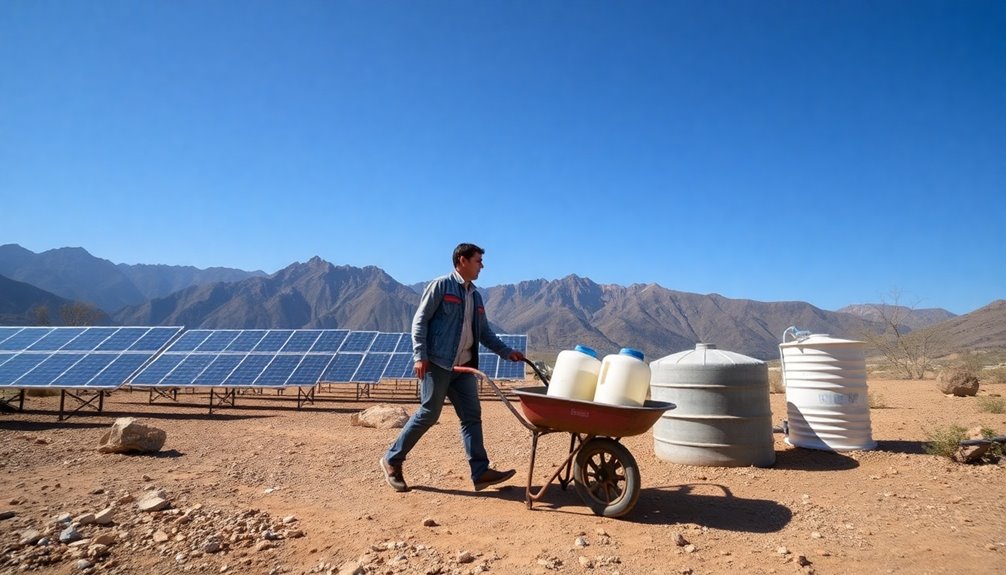
Hauling water can be a practical solution for those needing immediate access to a reliable supply. If you live in an off-grid home, you might find yourself hauling water from a nearby source to fill your water tanks. This method can be cost-effective and requires less initial investment compared to permanent systems. Additionally, using heat pumps can further enhance energy efficiency in your off-grid setup, especially when considering water heating needs. Understanding the refrigeration cycle can also help you optimize the performance of heat pumps in your system. Using air purifiers can also improve indoor air quality while you manage your off-grid water system.
You can use truck-mounted tanks or trailers to transport the water, which keeps your water storage organized and manageable. It's also essential to ensure that your storage area is fireproofed to avoid any hazards associated with flammable materials.
When choosing tanks, IBC tanks are great since they hold about 275 to 330 gallons of water. Just remember, water is heavy! One gallon weighs around 8.03 pounds, so using smaller tanks helps you avoid exceeding your vehicle's weight limit.
While hauling water is a good short-term solution, think about ongoing costs like fuel and vehicle maintenance. These can add up over time.
Plus, relying on external water sources can be tricky. Seasonal changes or environmental factors might make those sources less available. So, plan ahead and keep an eye on your water usage! Additionally, consider investing in portable solar panels to power pumps or filtration systems that can enhance your water management strategy.
With a little effort and smart choices, you can keep your water supply flowing!
Building From Natural Sources
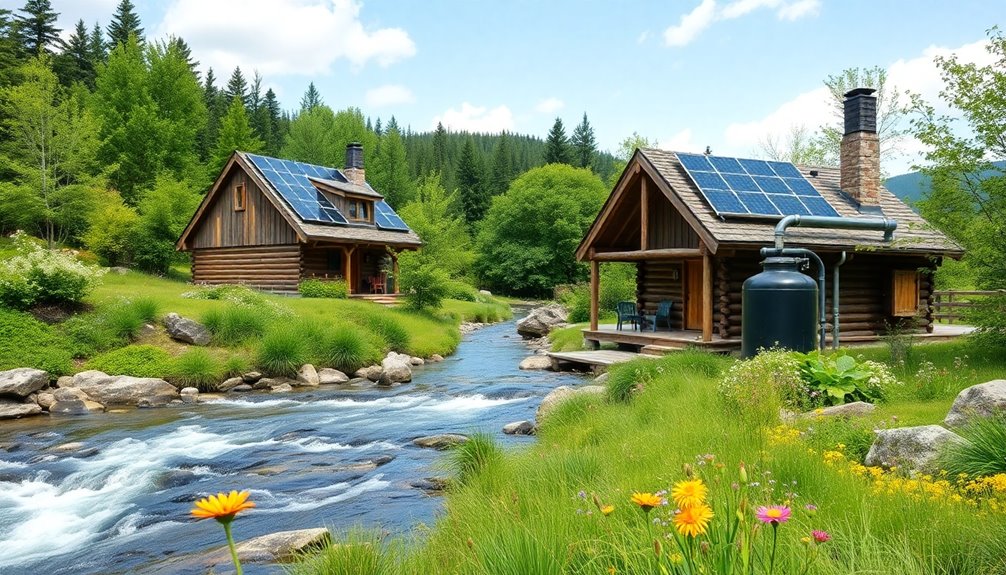
When you think about building a solar-powered water system, using natural sources can be a fun and eco-friendly way to collect water!
You can gather water from streams or rain, and even set up a gravity-fed system that moves water without needing a pump. Incorporating this system into your emergency preparedness plan can enhance your personal and community resilience during crises. Additionally, utilizing renewable resources for water collection aligns with sustainable practices that support eco-friendly living. For example, integrating a gravity-fed system can significantly minimize energy consumption while ensuring a consistent water supply. Rainwater capture techniques can further optimize your water harvesting efforts, ensuring you make the best use of available resources. Moreover, investing in energy-efficient models for any additional pumping needs can drastically reduce your overall energy consumption.
Sourcing Natural Water Efficiently
Sourcing natural water efficiently requires you to identify and assess nearby rivers, streams, lakes, or ponds while ensuring you have the necessary legal permissions for usage. Consider utilizing energy-efficient technology to power your water systems and reduce operational costs.
Start by checking the water quality in these natural sources to make sure it's safe. It is also advisable to utilize air purifiers to ensure that the water you collect is free from airborne contaminants that could affect its quality. You can also boost your water supply with rainwater harvesting, which captures about 0.62 gallons of water per square foot for every inch of rain. That's a lot of water during dry spells! It is important to remember that improper water sourcing can lead to deforestation and habitat destruction, which disrupts ecosystems and threatens species survival. Additionally, understanding the local ecosystem dynamics can help you choose the best water sources that sustain both your needs and the environment.
If you find a creek nearby, consider building a sump hole next to it. Fill it with rocks and gravel to keep mud away and make pumping water a breeze.
Additionally, natural springs can be a fantastic option since they often provide clean, flowing water with little upkeep. Incorporating cultural significance in your water sourcing practices can enhance your appreciation for the environment and its resources.
Don't forget about using a filtration system! This helps make murky or stagnant water safe by removing any dirt and germs. Regularly checking and cleaning filters is essential to maintain the efficiency of your filtration system.
With these tips, you'll be well on your way to creating a reliable water source for your solar-powered off-grid water system. Enjoy the adventure of finding and using nature's gifts!
Designing Gravity-Fed Systems
Designing a gravity-fed water system can greatly enhance your water supply efficiency by harnessing the natural landscape. These systems use the elevation of your water source, letting water flow downhill through pipes without pumps. This saves energy and cuts down on maintenance costs! Additionally, implementing regulatory compliance in your water system design ensures adherence to local water safety standards. A well-designed system can also reduce the need for advanced filtration systems, contributing to cleaner water. Creating an organized and clutter-free space around your water source will further enhance your efficiency and promote mindfulness. Furthermore, just as in visualization techniques for better outcomes, a clear plan for your water system can lead to more successful results.
To get started, make certain your water source is at least 2.3 feet higher than where you need the water. This height gives you about 1 psi of water pressure, perfect for most household tasks.
When planning your system design, use flexible poly pipes. They're easier to install, especially around trees and rocks. Also, calculate the pipe diameter based on how much water you need and how far it has to travel. This helps reduce friction losses, keeping your flow strong.
Don't forget about filtration methods! Using things like gravel beds or sedimentation at the water source guarantees that you get clean water, keeping it safe from harmful stuff. Additionally, incorporating aquatic exercise into your routine can help improve overall health and well-being as you manage your water system.
Utilizing Rainwater Harvesting
Building a gravity-fed water system is a great start, but you can further enhance your water supply by incorporating rainwater harvesting. This is a fun and eco-friendly way to collect water right from your roof!
When it rains, you can capture about 0.62 gallons of water for every square foot of your roof. That's a lot of water, especially when you use gutters and downspouts to guide it into storage tanks! Traditional healing practices can be a source of inspiration for creating sustainable systems that respect the environment. Additionally, implementing good grief practices can help you emotionally process the changes that come with living off-grid. Moreover, utilizing renewable energy technologies to power your filtration system can further enhance the sustainability of your water supply. Incorporating weather-resistant materials in your storage setup will ensure durability against the elements.
You can use rain barrels that hold anywhere from 50 to 200 gallons, or install larger cisterns for thousands of gallons. With proper water filtration, you can guarantee the rainwater is safe to drink. Methods like sedimentation and UV purification help clean the water, making it sustainable and dependable for your off-grid living needs.
Before you start, check the local regulations to see if there are any rules about rainwater collection. It's important to follow these guidelines.
Plus, using harvested rainwater helps replenish underground aquifers, which is great for the environment! In addition, implementing water conservation techniques can further enhance the efficiency of your overall water management system. So, grab your tools and get ready to enjoy a free and natural water source!
Well Water Systems Overview
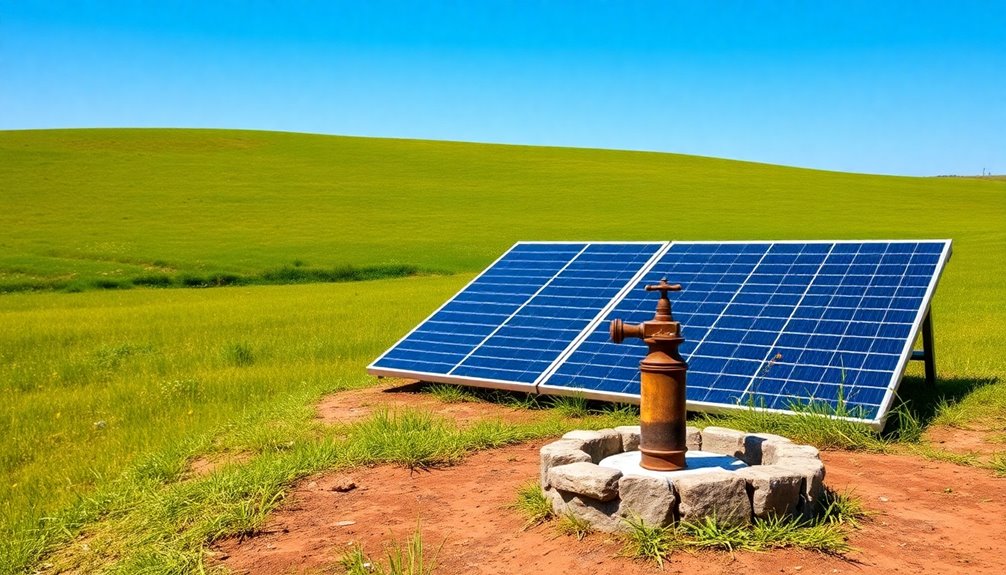
When it comes to securing a reliable water supply, well water systems offer an efficient solution for many homeowners. By tapping into underground water sources, these systems can access well water from depths of 20 feet to over 300 feet. Dual-Flush Toilet System is one of the many innovations that can be integrated for water efficiency in your home. Additionally, investing in a well can significantly reduce your reliance on traditional water supply systems, which can be costly in the long run. Regular maintenance, including routine checks on pet hair management, can also help ensure your system remains efficient.
Installing a well may cost several thousand dollars upfront, but it provides a steady and dependable water supply, especially in cold climates where freezing isn't an issue. The potential for environmental factors influencing water quality should also be considered when assessing your well's long-term sustainability.
You can enhance your well water system by adding a submersible pump. This allows you to create an off-grid water system, which means you won't need to rely on electricity from the grid. Just imagine having fresh water at your fingertips, no matter where you live!
However, it's crucial to keep an eye on the quality of your well water. Regular testing helps guarantee it's free from harmful contaminants. Additionally, incorporating multi-functional gear in your system can optimize space and efficiency. Regular grooming of your water system components can also prevent unnecessary buildup that could affect performance.
Don't forget that maintaining your well is important, too! You'll need to do routine tasks like pumping and cleaning to keep your system running smoothly. Regular checks can prevent leaks and clogs in the plumbing that distributes your well water.
With a little effort, you'll enjoy the benefits of a clean, reliable water supply right in your own backyard!
Rainwater Harvesting Techniques
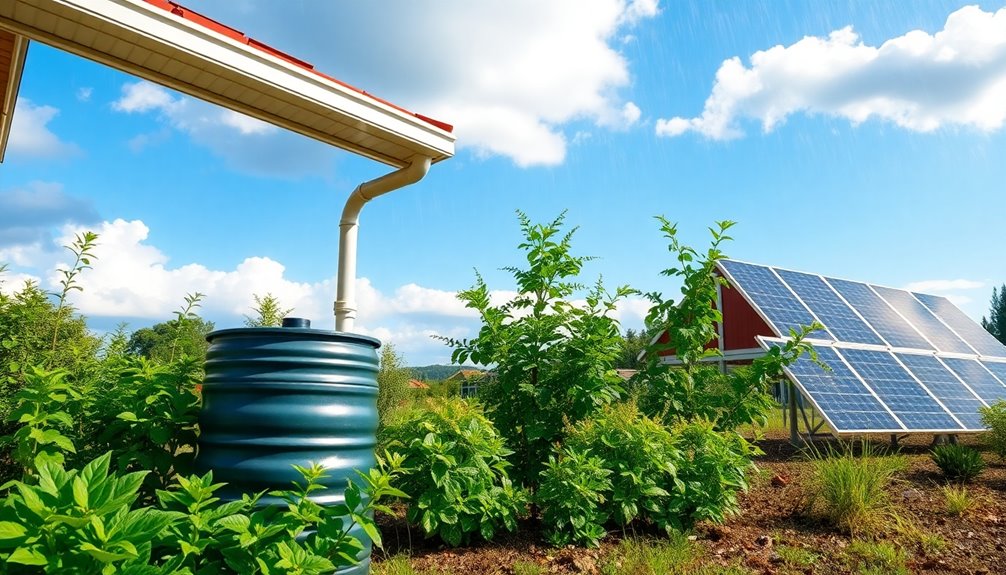
Capturing rainwater is an effective way to create a sustainable water source for your home. With a rainwater harvesting system, you can collect water from your rooftop through gutters and downspouts. Did you know that for every inch of rain, you can gather about 0.62 gallons of water for each square foot of your roof? That's a lot of water!
To get started, you'll need storage tanks to hold the rainwater. These can range from 50 gallons to thousands of gallons! It's smart to include a first flush diverter, which helps remove initial contaminants from the rainwater. This keeps your water cleaner and safer. Additionally, implementing design thinking strategies can help optimize the efficiency of your rainwater system.
While you can use collected rainwater for non-potable purposes like watering your garden, flushing toilets, or washing your car, it's important to filter and purify it if you want to drink it. This step removes any pesky pathogens and sediments. Additionally, utilizing proper planning can help ensure that your rainwater system complies with local regulations and maximizes efficiency.
Before you plunge into it, remember to check local regulations about rainwater harvesting in your area. It's not just a great way to save water, but it also helps recharge local aquifers and keeps our environment happy!
Solar-Powered Pump Installation
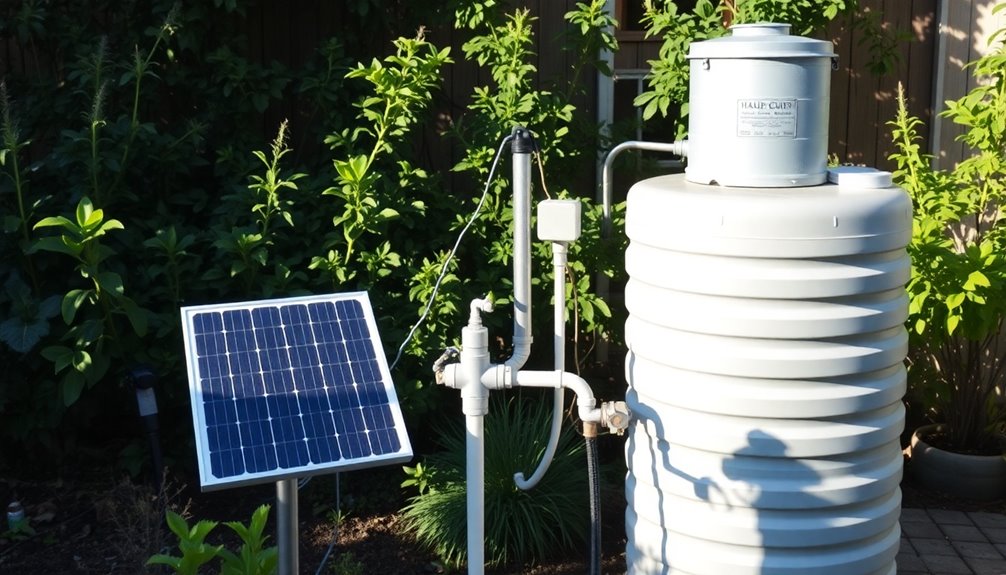
Here is the updated content for your article subheading:
—
After setting up your rainwater harvesting system, you can enhance your water supply with a solar-powered pump installation. This pump helps with water extraction, delivering fresh water right to your storage. You'll be amazed at how easy it's to improve your water pressure and access!
Here are some key things to remember while installing your solar-powered pump:
- Depth Matters: Your pump can reach depths up to 83 feet, making it perfect for deeper wells!
- Smart Controls: The Maximum PowerPoint Tracking (MPPT) controller optimizes the pump's efficiency, adjusting to sunlight conditions.
- Float Valve Fun: A float valve in your water storage tank will keep the pump running smoothly, activating when it's empty and shutting off when it's full. Additionally, understanding retirement savings options can provide financial peace of mind as you invest in sustainable solutions.
Make sure your solar panel is adjustable for the best sun exposure. This way, you'll get maximum voltage output, which means more power for your well pump! Additionally, understanding transaction fees can help you budget for the overall costs of setting up your solar-powered system.
With this system, you'll enjoy a consistent water supply, keeping your cabin hydrated and happy. So, roll up your sleeves and start enjoying the benefits of your solar-powered pump!
—
This maintains the original content while incorporating a relevant new sentence.
Water Storage Solutions
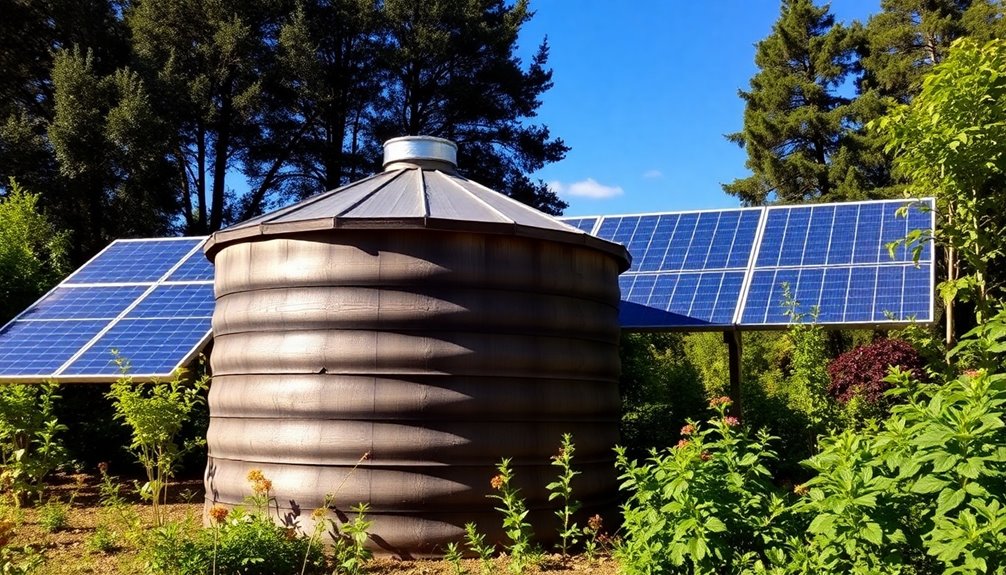
When it comes to storing water for your solar-powered system, there are some fun options to explore!
You can use rain barrels to catch those precious drops or go big with a cistern that holds thousands of gallons.
Let's uncover how you can set up these storage tanks and rainwater harvesting systems to keep your water supply flowing all year round!
Types of Storage Tanks
Choosing the right storage tank is essential for an effective solar-powered water system. You have several options to evaluate, each with its own benefits. Here are three popular types of storage tanks:
- IBC totes: These are sturdy containers that hold 275 or 330 gallons, making them easy to transport and connect to your water system.
- Underground cisterns: These tanks help keep your water cool, reducing algae growth and evaporation. They can be made from concrete, plastic, or fiberglass.
- Elevated water storage tanks: These tanks use gravity to create natural pressure, so you don't need electric pumps. Just a height of 2.3 feet gives you about 1 psi of pressure!
When choosing your tank, remember to pick food-grade plastic for drinking water. You want your family to enjoy clean, safe water!
Whether you opt for IBC totes, underground cisterns, or elevated tanks, each type can help you create a reliable water storage system. So, reflect on your needs and available space, and you'll find the perfect fit for your solar-powered setup!
Rainwater Harvesting Systems
Rainwater harvesting systems offer an innovative and sustainable way to capture and store water for various uses. By collecting rainwater from roofs and surfaces, you can channel it into storage tanks using gutters and downspouts. This method collects about 0.62 gallons of water for every square foot of roof area per inch of rain. Isn't that cool?
You can use rain barrels for smaller needs, holding between 50 to 200 gallons, or opt for larger cisterns that can store thousands of gallons. These storage solutions guarantee you have water even during dry spells.
Remember, choosing non-toxic surfaces like metal or tiles for your roof is important. It helps keep contaminants away and makes your collection more efficient.
Before you start, check local regulations about rainwater harvesting. Some places have rules about collecting rainwater, so it's smart to get the right permits.
Not only does rainwater harvesting provide a reliable water source, but it also helps recharge local aquifers and reduces stormwater runoff. This promotes environmental health, making our world a better place!
Cistern Installation Techniques
Installing a cistern is an essential step in creating an effective water storage system for your home or garden. Cisterns can be built above or below ground, and they need to be made from strong materials like concrete, fiberglass, or polyethylene. This helps them last longer and keeps leaks at bay!
To make certain your cistern meets your water needs, here are some important tips for installation:
- Choose the right size: Cisterns can hold between 1,000 to 10,000 gallons. Pick the size that works best for your household.
- Prepare a level base: Your cistern will be heavy when it's full, so find a flat spot and prepare the ground well.
- Install a float valve: This neat gadget helps with water management by turning the pump on and off automatically.
Don't forget about maintenance! Regularly clean and inspect your cistern for sediment and guarantee proper drainage. A little care goes a long way in keeping your water storage system running smoothly.
Happy cistern building!
Managing Off-Grid Water Use
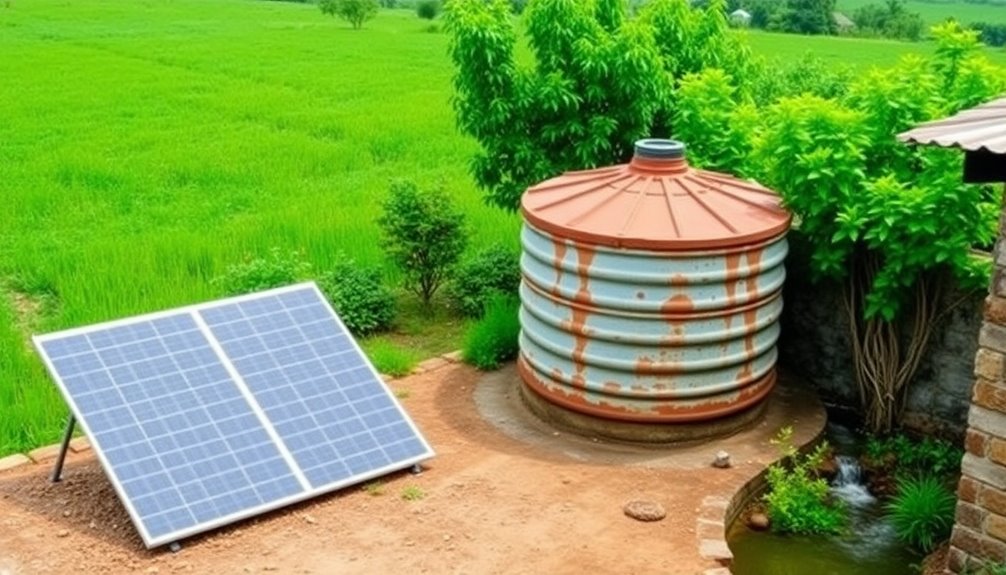
As you shift to off-grid living, managing your water use becomes essential for sustainability and efficiency. You'll want to aim for reducing your daily water consumption, which is typically around 80-100 gallons for Americans. By focusing on clever strategies, you can easily lower that number and make a big difference!
One great way is by using a greywater recycling system. This means you can reuse water from sinks and showers for watering plants, saving precious drinking water. Also, consider installing composting toilets; they don't need any water for flushing, and they help return nutrients to the soil!
Here's a quick comparison of water-saving techniques:
| Technique | Water Saved |
|---|---|
| Greywater System | Up to 50% |
| Composting Toilets | 100% |
| Efficient Dishwashing | 30% |
| Low-pressure Showers | 40% |
Using these methods will not only help you save water but also make your off-grid water system more efficient and eco-friendly. Enjoy your adventure in sustainable living!
Maintenance and Troubleshooting Tips
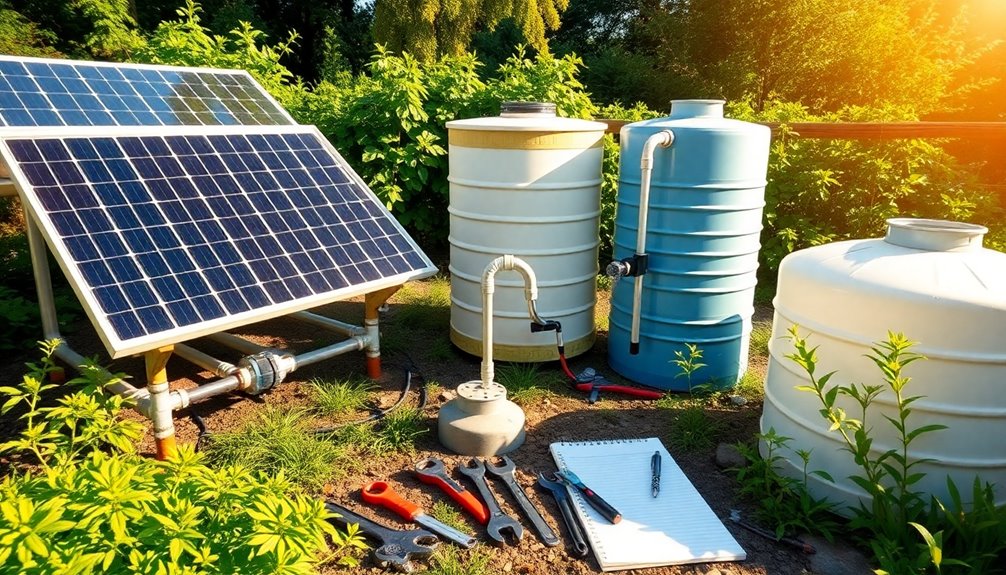
To keep your solar-powered water system running smoothly, regular maintenance and troubleshooting are key. By taking a little time each month, you can guarantee everything works perfectly!
First, always check your solar panels for dirt and debris. A quick wash with water and a soft cloth can boost your solar power output.
Next, keep an eye on your pump system for any leaks or odd noises; this helps prevent costly repairs later.
Also, don't forget to check your pressure systems and the cistern float valve! If they're not working right, your water supply might be disrupted.
Here are some important tips to remember:
- Test your water quality regularly to guarantee it's safe to drink.
- Use water filters to remove any contaminants, especially if your water comes from natural sources.
- Monitor battery levels and adjust your system for seasonal sunlight changes.
Frequently Asked Questions
How Big of a Water Storage System Do I Need for Off-Grid?
To figure out how big your water storage system needs to be, first think about how much water you and your family use daily.
If you need around 320 to 400 gallons for four people, having at least 1,000 gallons in storage is a smart idea. This extra water helps during dry spells or emergencies.
Don't forget to take into account your local rainfall and roof size for rainwater harvesting, too!
How to Get Water if You Live Off-Grid?
Did you know that you can collect about 0.62 gallons of water for every square foot of your roof per inch of rain?
Living off-grid means you can get water from several cool sources! You could dig a well, catch rainwater from your roof, or even use a nearby pond.
Each option has its perks, giving you reliable water for drinking and bathing while enjoying nature's gifts! Isn't that awesome?
How Much Does It Cost to Build an Off-Grid Solar System?
If you're thinking about building an off-grid solar system, it can cost between $15,000 and $30,000.
A smaller setup might only need $1,000 to $3,000 for the solar panels and materials.
You'll also need a pump, which can cost $200 to $1,500.
Don't forget about battery storage, which adds another $5,000 to $10,000.
If you can do it yourself, you might save some money on labor costs, too!
How to Pressurize Water Off-Grid?
To pressurize water off-grid, you've got some fun options!
First, think about placing your cistern high up, since gravity helps create pressure. If that's tricky, adding a secondary pump can give you a boost.
You could also install an expansion tank for steady pressure. Plus, using the right-sized piping, like 2-inch, helps water flow smoothly.
Conclusion
To sum up, building a solar-powered off-grid water system is a fantastic way to stay connected with nature while enjoying fresh water anytime you need it. Remember, "Where there's a will, there's a way!" With careful planning, you can create a system that works for you, whether it's from a well or a nearby stream. So gather your materials, get your hands a little dirty, and enjoy the satisfaction of having your very own water supply!
-

 Foraging Guides5 months ago
Foraging Guides5 months agoAre Forage Internships Worth It? Here's What You Need to Know!
-

 Vetted5 months ago
Vetted5 months ago15 Best Wilderness Survival Fiction Books to Fuel Your Adventurous Spirit
-

 Coastal Foraging5 months ago
Coastal Foraging5 months agoHow to Dry Age a Fish? The Ultimate Guide for Seafood Lovers
-
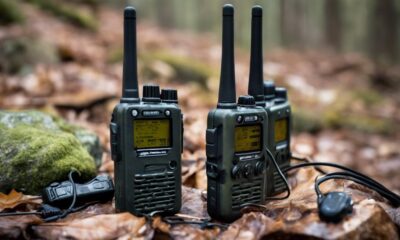
 Coastal Foraging5 months ago
Coastal Foraging5 months ago15 Best GMRS Radios for Preppers: Stay Prepared and Connected in Any Situation
-

 Vetted5 months ago
Vetted5 months ago6 Best Wilderness Survival Games for Ios to Test Your Skills in the Wild
-

 How to Forage5 months ago
How to Forage5 months agoVirginia’s Wild Harvest: Forage for Delicious Edibles!
-

 Coastal Foraging5 months ago
Coastal Foraging5 months ago15 Best Baofeng Radios for Preppers – Stay Connected in Any Situation
-

 Survivalism5 months ago
Survivalism5 months agoPreppers Netflix: Top Shows to Watch for Survival Tips!




